1. This document contains examples of finding antiderivatives (indefinite integrals) of various functions.
2. The examples demonstrate using basic integration rules like power rule, reverse derivative rule, trigonometric integral formulas to find antiderivatives.
3. Additional examples show using initial conditions to determine an unknown constant term when an antiderivative is given in terms of an arbitrary constant.


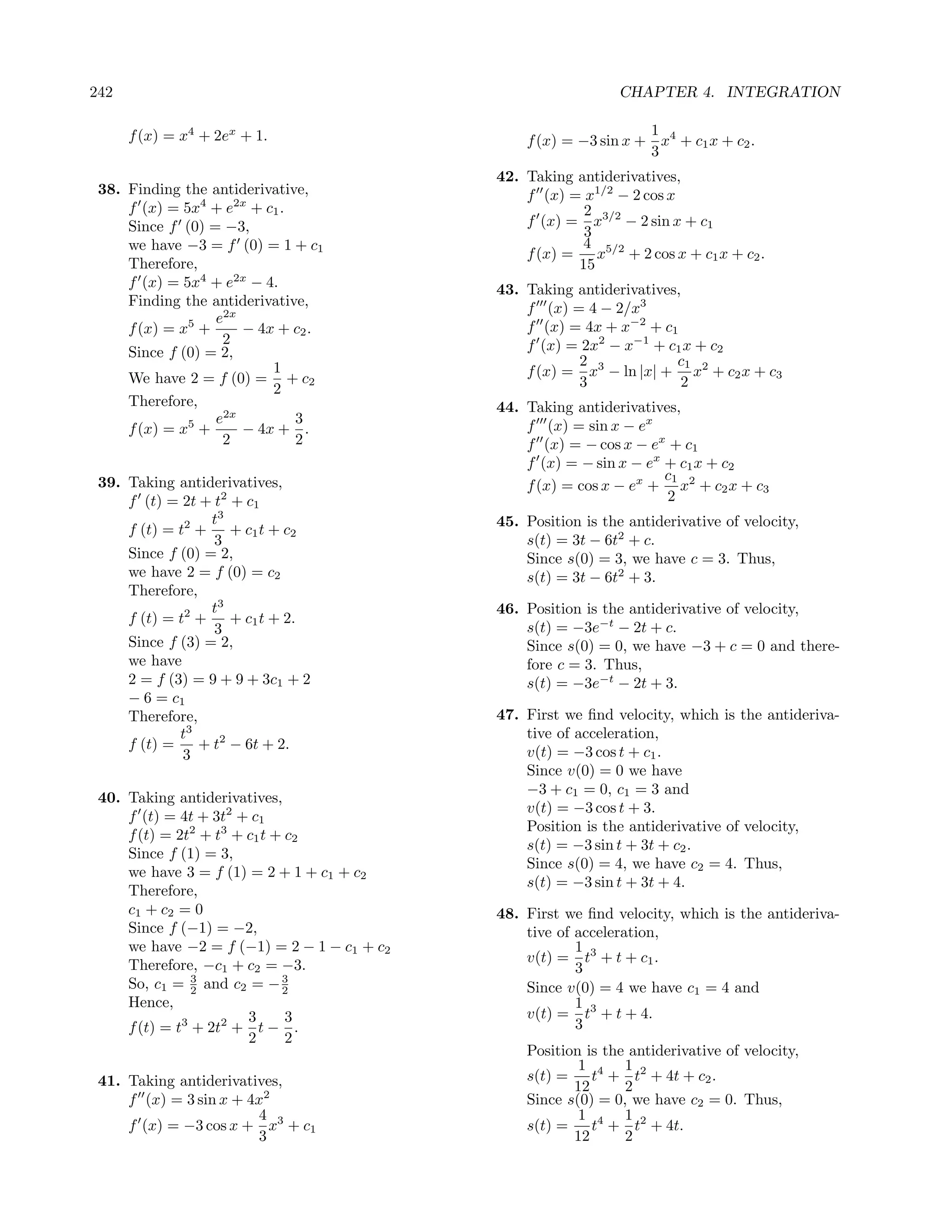
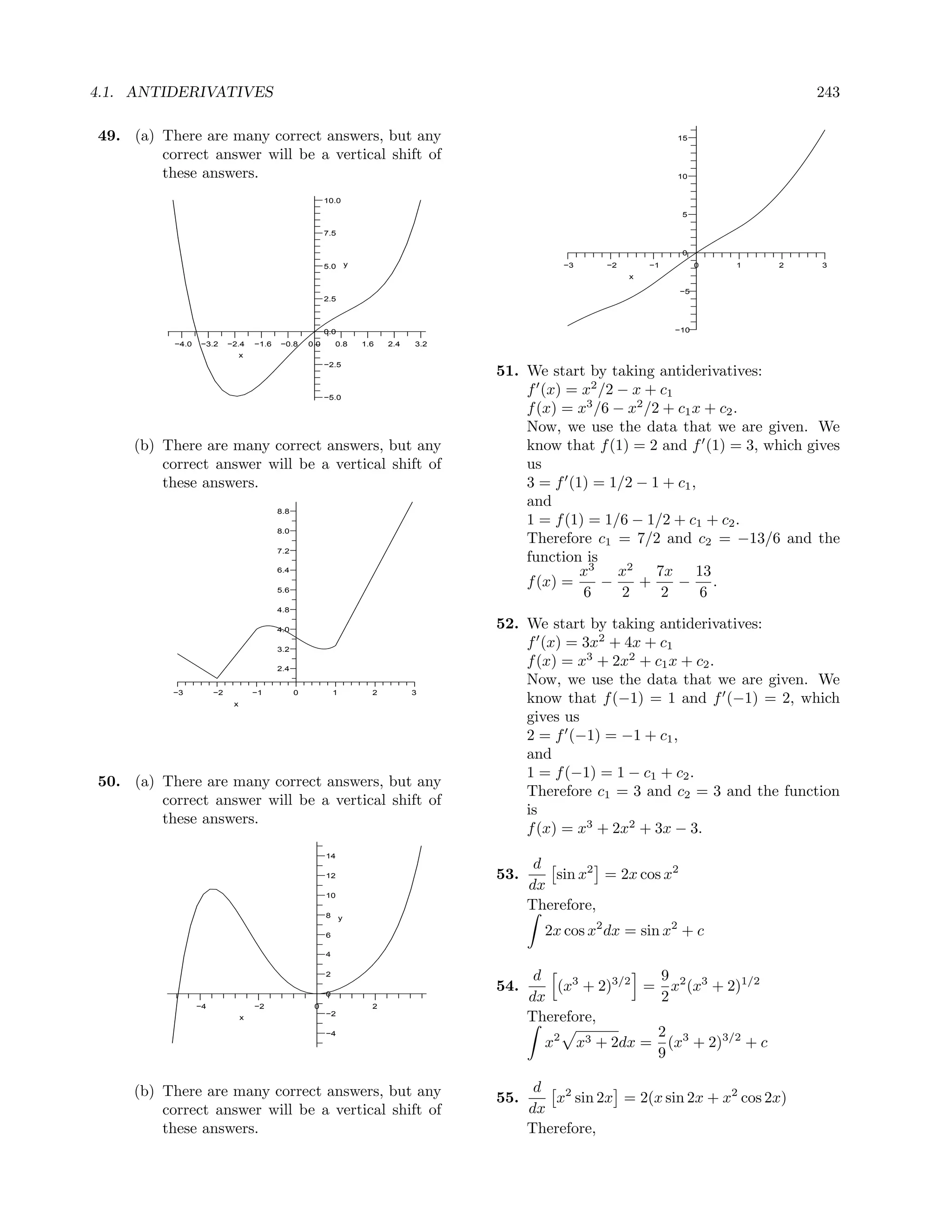
![244 CHAPTER 4. INTEGRATION
1 36 x2
x sin 2x + x2 cos 2x dx = 3− = 2
9 12 − 9x 2 3x − 4
1 2 For 33(a): Almost the same as in Exercise 59,
= x sin 2x + c
2 example 1.11 (b).
1 x−1
d x2 2xe3x − 3x2 e3x For 34(b): ln +c
56. = 2 x+1
dx e 3x e6x Verify:
Therefore, d 1 x−1
ln
2xe3x − 3x2 e3x x2 dx 2 x + 1
6x
dx = 3x + c 1 x + 1 (x + 1) − (x − 1)
e e = · ·
2 x−1 (x + 1)2
x cos(x2 ) 1
57. dx = sin(x2 ) + c = 2
sin(x2 ) x −1
61. Use a CAS to find antiderivatives and verify by
d √ √ 1 computing the derivatives:
58. 2 x sin x = 2 x cos x + √ sin x
dx x
√ 1 3 1 3
2 x cos x + √ sin x dx (a) x2 e−x dx = − e−x + c
x 3
√ Verify:
= 2 x sin x + c d 1 3
− e−x
dx 3
59. Use a CAS to find antiderivatives and verify by 1 3
= − e−x · (−3x2 )
computing the derivatives: 3 3
For 11.1(b): = x2 e−x
1
sec xdx = ln | sec x + tan x| + c (b) dx = ln |x − 1| − ln |x| + c Verify:
x2 − x
Verify: d
(ln |x − 1| − ln |x|)
d dx
ln | sec x + tan x| 1 1 x − (x − 1)
dx = − =
sec x tan x + sec2 x x−1 x x(x − 1)
= = sec x 1 1
sec x + tan x = = 2
For 11.1(f): x(x − 1) x −x
sin 2x x cos 2x
x sin 2xdx = − +c (c) sec xdx = ln | sec x + tan x| + c
4 2
Verify: Verify:
d sin 2x x cos 2x d
− [ln | sec x + tan x|]
dx 4 2 dx
2 cos 2x cos 2x − 2x sin 2x sec x tan x + sec2 x
= − =
4 2 sec x + tan x
= x sin 2x sec x(sec x + tan x)
= = sec x
sec x + tan x
60. Use a CAS to find antiderivatives and verify by
computing the derivatives: 62. Use a CAS to find antiderivatives and verify
For 31(a): The answer is too complicated to be by computing the derivatives:
presented here.
√
1 √ 2 3 − 3x x 1
For 32(b): 3x + 3 ln √ +c (a) dx = arctan x2 + c
9 2 3 + 3x x4 + 1 2
Verify: Verify:
√ d 1
d 1 √ 2 3 − 3x arctan x2
3x + 3 ln √ dx 2
dx 9 2 3 + 3x
√ 1 1 x
1 2 3 + 3x = · 4 · 2x = 4
= 3+ √ · 2 x +1 x +1
9 2 3 − 3x
√ √ (b) 3x sin 2xdx
−3(2 3 + 3x) − 3(2 3 − 3x)
√ 3 3x
(2 3 + 3x)2 = sin 2x − cos 2x + c
4 2](https://image.slidesharecdn.com/ismetchapter4-111124021901-phpapp01/75/answers-tutor-8-5-2048.jpg)
![4.1. ANTIDERIVATIVES 245
Verify: 67. The key is to find the velocity and position
d 3 3x functions. We start with constant acceleration
sin 2x − cos 2x
dx 4 2 a, a constant. Then, v(t) = at + v0 where v0
3 3 is the initial velocity. The initial velocity is 30
= cos 2x − cos 2x + 3x sin 2x
2 2 miles per hour, but since our time is in seconds,
= 3x sin 2x it is probably best to work in feet per second
(30mph = 44ft/s). v(t) = at + 44.
(c) ln xdx = x ln x − x + c We know that the car accelerates to 50 mph
Verify: (50mph = 73ft/s) in 4 seconds, so v(4) = 73.
d 29
(x ln x − x) = ln x + 1 − 1 Therefore, a · 4 + 44 = 73 and a = ft/s
dx 4
= ln x So,
29
−1 v(t) = t + 44 and
63. √ dx = cos−1 (x) + c1 4
1 − x2 29 2
s(t) = t + 44t + s0
−1 8
√ dx = − sin−1 (x) + c2 where s0 is the initial position. We can assume
1 − x2 the the starting position is s0 = 0.
Therefore, 29 2
cos−1 x + c1 = − sin−1 x + c2 Then, s(t) = t + 44t and the distance
8
Therefore, traveled by the car during the 4 seconds is
sin−1 x + cos−1 x = constant s(4) = 234 feet.
To find the value of the constant, let x be any
convenient value. 68. The key is to find the velocity and position
Suppose x = 0; then sin−1 0 = 0 and cos−1 0 = functions. We start with constant acceleration
π/2, so a, a constant. Then, v(t) = at + v0 where v0
π is the initial velocity. The initial velocity is 60
sin−1 x + cos−1 x =
2 miles per hour, but since our time is in seconds,
it is probably best to work in feet per second
64. To derive these formulas, all that needs to be
(60mph = 88ft/s). v(t) = at + 88.
done is to take the derivatives to see that the
We know that the car comes to rest in 3 sec-
integrals are correct:
d onds, so v(3) = 0.
(tan x) = sec2 x Therefore,
dx
d a(3) + 88 = 0 and a = −88/3ft/s (the accelera-
(sec x) = sec x tan x tion should be negative since the car is actually
dx
decelerating.
65. To derive these formulas, all that needs to be So,
done is to take the derivatives to see that the 88
integrals are correct: v(t) = − t + 88 and
3
d x 44
(e ) = ex s(t) = − t2 + 88t + s0 where s0 is the initial
dx 3
d position. We can assume the the starting po-
−e−x = e−x
dx sition is s0 = 0.
44
1 1 1 Then, s(t) = − t2 + 88t and the stopping
66. (a) dx = dx 3
kx k x distance is s(3) = 132 feet.
1
= ln |x| + c1 69. To estimate the acceleration over each inter-
k
val, we estimate v (t) by computing the slope
1 1 k
(b) dx = dx of the tangent lines. For example, for the in-
kx k kx terval [0, 0.5]:
1
= ln |kx| + c2 v(0.5) − v(0)
k a≈ = −31.6 m/s2 .
0.5 − 0
Because Notice, acceleration should be negative since
1 1
ln |kx| = (ln |k| + ln |x|) the object is falling.
k k
1 1 1 To estimate the distance traveled over the in-
= ln |x| + ln |k| = ln |x| + c terval, we estimate the velocity and multiply
k k k
The two antiderivatives are both correct. by the time (distance is rate times time). For](https://image.slidesharecdn.com/ismetchapter4-111124021901-phpapp01/75/answers-tutor-8-6-2048.jpg)
![246 CHAPTER 4. INTEGRATION
an estimate for the velocity, we will use the Time Speed Dist
average of the velocities at the endpoints. For 0 70 0
example, for the interval [0, 0.5], the time inter- 0.5 69.55 34.89
val is 0.5 and the velocity is −11.9. Therefore 1.0 70.3 69.85
the position changed is (−11.9)(0.5) = −5.95 1.5 70.35 105.01
meters. The distance traveled will be 5.95 me- 2.0 70.65 104.26
ters (distance should be positive).
Interval Accel Dist 72. To estimate the speed over the interval, we first
[0.0, 0.5] −31.6 5.95 approximate the acceleration over the interval
[0.5, 1.0] −2 12.925 by averaging the acceleration at the endpoint
[1.0, 1.5] −11.6 17.4 of the interval. Then, the velocity will be the
[1.5, 2.0] −3.6 19.3 acceleration times the length of time. the slope
of the tangent lines. For example, for the in-
terval [0.0, 0.5] the average acceleration is −0.8
and v(0.5) = 20+(−0.8)(.5) = 19.6. Of course,
speed is the absolute value of the velocity.
70. To estimate the acceleration over each inter-
And, the distance traveled is the average speed
val, we estimate v (t) by computing the slope
times the length of time. For the time t = 0.5,
of the tangent lines. For example, for the in- 20 + 19.6
terval [0, 1.0]: the distance would be × 0.5 = 9.9
2
v(1.0) − v(0) meters.
a≈ = −9.8 m/s2 . Time Speed Dist
1.0 − 0
Notice, acceleration should be negative since 0 20 0
the object is falling. 0.5 19.6 9.9
To estimate the distance traveled over the in- 1.0 17.925 19.281
terval, we estimate the velocity and multiply 1.5 16.5 27.888
by the time (distance is rate times time). For 2.0 16.125 34.044
an estimate for the velocity, we will use the av-
erage of the velocities at the endpoints. For
example, for the interval [0, 1.0], the time in- 4.2 Sums And Sigma Notation
terval is 1.0 and the velocity is −4.9. Therefore
the position changed is (−4.9)(1.0) = −4.9 me- 1. The given sum is the sum of twice the
ters. The distance traveled will be 4.9 meters squares of the integers from 1 to 14.
(distance should be positive). 14
2 2 2 2
Interval Accel Dist 2(1) + 2(2) + 2(3) + . . . + 2(14) = 2i2
i=1
[0.0, 1.0] −9.8 4.9
[1.0, 2.0] −8.8 14.2 2. The given sum is the sum of squares
[2.0, 3.0] −6.3 21.75 roots of √the integers from 1 to 14.
√ √ √
[3.0, 4.0] −3.6 26.7 2 − 1 + 3 − 1 + 4 − 1 + . . . + 15 − 1
√ √ √ √ √
= 1 + 2 + 3 + ... + 13 + 14
14
√
= i
71. To estimate the speed over the interval, we i=1
first approximate the acceleration over the in-
terval by averaging the acceleration at the end- 50
(50)(51)(101)
point of the interval. Then, the velocity will be 3. (a) i2 = = 42, 925
6
the acceleration times the length of time. The i=1
slope of the tangent lines. For example, for the 50 2
2
50(51)
interval [0, 0.5] the average acceleration is −0.9 (b) i = = 1, 625, 625
and v(0.5) = 70 + (−0.9)(0.5) = 69.55. i=1
2
And, the distance traveled is the speed times
10
the length of time. For the time t = 0.5, the √
70 + 69.55 4. (a) i
distance would be ×0.5 ≈ 34.89 me- i=1
2 √ √ √ √ √
ters. =1+ 2+ 3+ 4+ 5+ 6](https://image.slidesharecdn.com/ismetchapter4-111124021901-phpapp01/75/answers-tutor-8-7-2048.jpg)
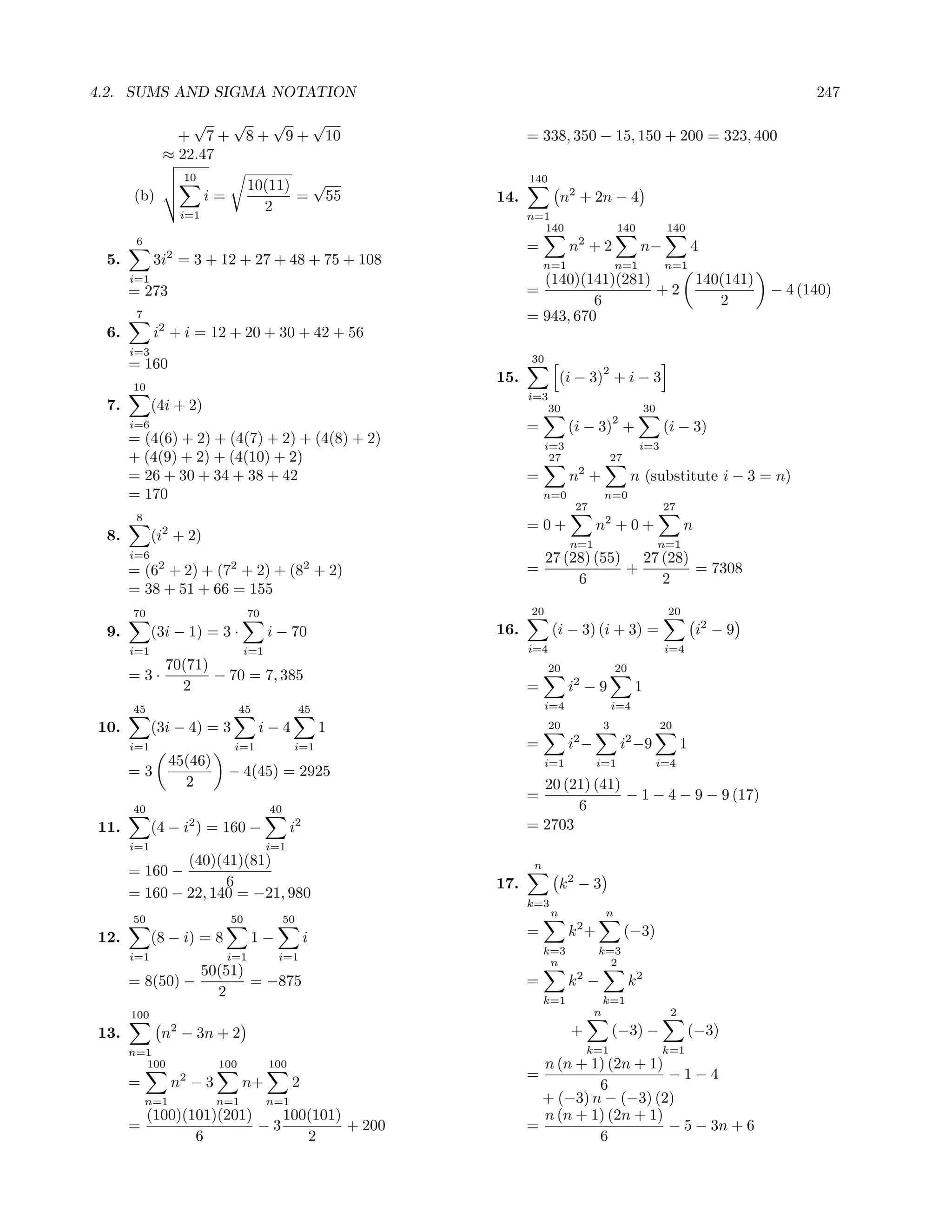
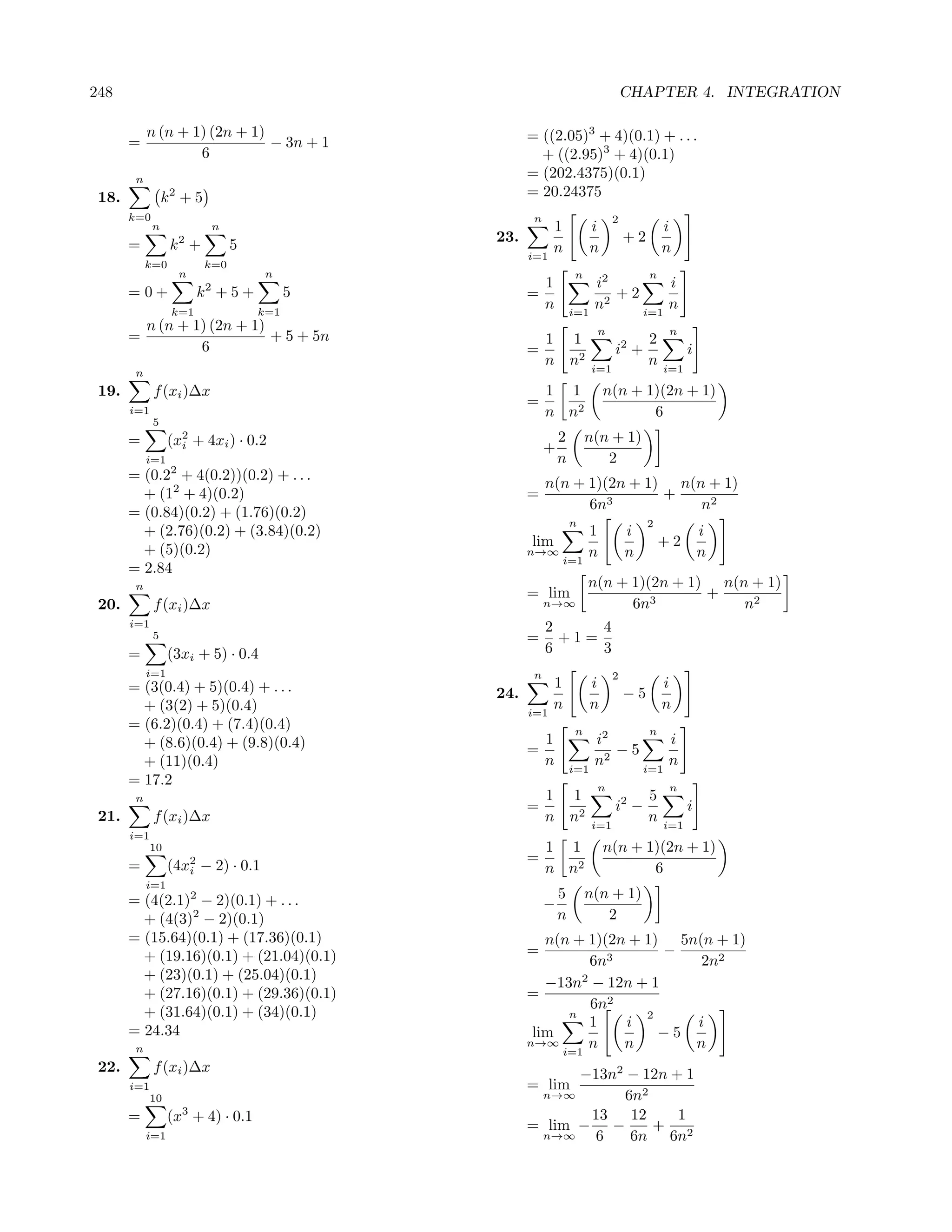
![4.2. SUMS AND SIGMA NOTATION 249
13 n
=− n2 (n + 1)2
6 i3 =
i=1
4
n
1 2i
2
2i is true for all integers n ≥ 1.
25. 4 − For n = 1, we have
n n n 1
i=1 12 (1 + 1)2
n n i3 = 1 = ,
1 i2 i i=1
4
= 16 −2
n i=1
n2 i=1
n as desired.
So the proposition is true for n = 1.
n n
1 16 2 Next, assume that
= i2 − i k
n n2 n k 2 (k + 1)2
i=1 i=1 i3 = ,
1 16 n(n + 1)(2n + 1) i=1
4
= for some integer k ≥ 1.
n n2 6
In this case, we have by the induction assump-
2 n(n + 1) tion that for n = k + 1,
−
n 2 n k+1 k
i3 = i3 = i3 + (k + 1)3
16n(n + 1)(2n + 1) n(n + 1)
= − i=1 i=1 i=1
6n3 n2 k 2 (k + 1)2
n 2 = + (k + 1)3
1 2i 2i 4
lim 4 − k 2 (k + 1)2 + 4(k + 1)3
n→∞
i=1
n n n =
4
16n(n + 1)(2n + 1) n(n + 1) (k + 1)2 (k 2 + 4k + 4)
= lim − =
n→∞ 6n3 n2 4
(k + 1)2 (k + 2)2
16 13 =
= −1= 4
3 3 n2 (n + 1)2
=
n 2 4
1 2i i as desired.
26. +4
i=1
n n n
28. Want to prove that
n n n
1 4i2 i n2 (n + 1)2 (2n2 + 2n − 1)
= +4 i5 =
n i=1
n2 i=1
n 12
i=1
n n is true for all integers n ≥ 1.
1 4 4 For n = 1, we have
= i2 + i
n n2 i=1
n i=1
1
12 (1 + 1)2 (2 + 2 − 1)
i3 = 1 = ,
1 4 n(n + 1)(2n + 1) i=1
12
=
n n2 6 as desired.
So the proposition is true for n = 1.
4 n(n + 1)
+ Next, assume that
n 2 k
k 2 (k + 1)2 (2k 2 + 2k − 1)
4n(n + 1)(2n + 1) 4n(n + 1) i5 = ,
= + i=1
12
6n3 2n2 for some integer k ≥ 1.
2
10n + 12n + 2 In this case, we have by the induction assump-
=
3n2 tion that for n = k + 1,
n 2 n k+1 k
1 2i i
lim +4 i5 = i5 = i5 + (k + 1)5
n→∞
i=1
n n n i=1 i=1 i=1
k 2 (k + 1)2 (2k 2 + 2k − 1)
10n + 12n + 2 2
= + (k + 1)5
= lim 12
n→∞ 3n2
10 12 2 10 k 2 (k + 1)2 (2k 2 + 2k − 1) + 12(k + 1)5
= lim + + = =
n→∞ 3 3n 3n2 3 12
(k + 1)2 [k 2 (2k 2 + 2k − 1) + 12(k + 1)3 ]
27. Want to prove that =
12](https://image.slidesharecdn.com/ismetchapter4-111124021901-phpapp01/75/answers-tutor-8-10-2048.jpg)
![250 CHAPTER 4. INTEGRATION
(k + 1)2 [2k 4 + 14k 3 + 35k 2 + 36k + 12] a − ar
= 34. When n = 0, a = .
12 1−r
Assume the formula holds for n = k − 1, which
(k + 1) (k + 4k + 4)(2k 2 + 6k + 3)
2 2
gives
=
12 a − ark
a + ar + · · · ark−1 = .
n2 (n + 1)2 (2n2 + 2n − 1) 1−r
= Then for n = k,
12
as desired. we have a + ar + · · · ark
10
= a + ar + · · · ark−1 + ark
a − ark
29. (i3 − 3i + 1) = + ark
1−r
i=1
10 10 a − ark + ark (1 − r)
=
= i3 − 3 i + 10 1−r
i=1 i=1 a − ark + ark − ark+1
=
100(11)2 10(11) 1−r
= −3 + 10 a − ark+1
4 2 =
= 2, 870 1−r
a − arn+1
=
20 1−r
30. (i3 + 2i) as desired.
i=1
20 20
n
= i3 + 2 i 6
35. e6i/n
i=1 i=1
i=1
n
400(21)2 20(21) n
= +2 = 44, 520 6
4 2 = e6i/n
n i=1
100
31. (i5 − 2i2 ) 6 e6/n − e6
=
i=1 n 1 − e6/n
100 100
= 5
i −2 i2 6 1 − e6
= −1
i=1 i=1 n 1 − e6/n
(100 )(1012 )[2(1002 ) + 2(100) − 1]
2 6 1 − e6 6
= = −
12 n 1 − e6/n n
6
100(101)(201) Now lim = 0, and
−2 x→∞ n
6
= 171, 707, 655, 800 6 1 − e6
lim
x→∞ n 1 − e6/n
100
1/n
32. (2i5 + 2i + 1) = 6(1 − e6 ) lim
x→∞ 1 − e6/n
i=1
100 100 1
= 6(1 − e6 ) lim
=2 i5 + 2 i + 100 x→∞ −6e6/n
i=1 i=1
= e6 − 1.
2 2 2 n
(100 )(101 )[2(100 ) + 2(100) − 1] 6
=2 Thus lim e6i/n = e6 − 1.
12 x→∞ n
i=1
100(101)
+2· + 100
2 n
= 343, 416, 675, 200 2
36. e(2i)/n
i=1
n
n n n
33. (cai + dbi ) = cai + dbi 2 e2/n − e2
=
i=1 i=1 i=1 n 1 − e2/n
n n
=c ai + d bi 2 1 − e2
= −1
i=1 i=1 n 1 − e2/n](https://image.slidesharecdn.com/ismetchapter4-111124021901-phpapp01/75/answers-tutor-8-11-2048.jpg)

Now lim = 0, and
x→∞ n = [(0.125)2 + 1 + (0.375)2 + 1
2 1 − e2 + (0.625)2 + 1 + (0.875)2 + 1](0.25)
lim
x→∞ n 1 − e2/n = 1.38125.
1/n
= 2(1 − e2 ) lim 2
x→∞ 1 − e2/n
1
= 2(1 − e2 ) lim
1.5
x→∞ −2e2/n
= e2 − 1. 1
n
2
Thus lim e2i/n = e2 − 1.
x→∞
i=1
n 0.5
37. Distance 0
= 50(2) + 60(1) + 70(1/2) + 60(3) 0 0.2 0.4 0.6
x
0.8 1 1.2
= 375 miles.
38. Distance
= 50(1) + 40(1) + 60(1/2) + 55(3)
= 285 miles. (b) Evaluation points:
0.25, 0.75, 1.25, 1.75.
39. On the time interval [0, 0.25], the estimated ve- Notice that ∆x = 0.5.
120 + 116 A4 = [f (0.25) + f (0.75) + f (1.25)
locity is the average velocity = 118
2 + f (1.75)](0.5)
feet per second. = [(0.25)2 + 1 + (0.75)2 + 1 + (1.25)2
We estimate the distance traveled during the + 1 + (1.75)2 + 1](0.5)
time interval [0, 0.25] to be = 4.625.
(118)(0.25 − 0) = 29.5 feet.
Altogether, the distance traveled is estimated 7
as
6
= (236/2)(0.25) + (229/2)(0.25)
+ (223/2)(0.25) + (218/2)(0.25) 5
+ (214/2)(0.25) + (210/2)(0.25) 4
+ (207/2)(0.25) + (205/2)(0.25) 3
= 217.75 feet. 2
40. On the time interval [0, 0.5], the estimated ve- 1
10 + 14.9 0
locity is the average velocity = 12.45 -0.5 0 0.5 1 1.5 2 2.5
2 x
meters per second. We estimate the distance
fallen during the time interval [0, 0.5] to be
(12.45)(0.5 − 0) = 6.225 meters.
Altogether, the distance fallen (estimated)
= (12.45)(0.5) + (17.35)(0.5)
+ (22.25)(0.5) + (27.15)(0.5)
+ (32.05)(0.5) + (36.95)(0.5)
+ (41.85)(0.5) + (46.75)(0.5) 2. (a) Evaluation points:
= 118.4 meters. 1.125, 1.375, 1.625, 1.875.
Notice that ∆x = 0.25.
A4 = [f (1.125) + f (1.375) + f (1.625)
4.3 Area + f (1.875)](0.25)
= [(1.125)3 − 1 + (1.375)3 − 1
1. (a) Evaluation points: + (1.625)3 − 1 + (1.875)3 − 1](0.25)
0.125, 0.375, 0.625, 0.875. = 2.7265625.](https://image.slidesharecdn.com/ismetchapter4-111124021901-phpapp01/75/answers-tutor-8-12-2048.jpg)

= [sin(π/16) + sin(3π/16) + sin(5π/16)
3
+ sin(7π/16) + sin(9π/16)
2 + sin(11π/16) + sin(13π/16)
1 + sin(15π/16)](π/8)
= 2.0129.
0
1 1.2 1.4 1.6 1.8 2
x 1
(b) Evaluation points: 0.8
1.25, 1.75, 2.25, 2.75.
Notice that ∆x = 0.5. 0.6
A4 = [f (1.25) + f (1.75) + f (2.25)
+ f (2.75)](0.5) 0.4
= [(1.25)3 − 1 + (1.75)3 − 1
+ (2.25)3 − 1 + (2.75)3 − 1](0.5)
0.2
= 17.75. 0
0 0.5 1 1.5 2 2.5 3
x
30
25
20
15
4. (a) Evaluation points:
−0.75, −0.25, 0.25, 0.75.
10
Notice that ∆x = 0.5.
5
A4 = [f (−0.75) + f (−0.25) + f (0.25)
0 + f (0.75)](0.5)
1 1.5 2 2.5 3
x = [4 − (−0.75)2 + 4 − (−0.25)2 + 4
− (0.25)2 + 4 − (0.75)2 ](0.5)
3. (a) Evaluation points: = 7.375.
π/8, 3π/8, 5π/8, 7π/8. 4
Notice that ∆x = π/4.
A4 = [f (π/8) + f (3π/8) + f (5π/8) 3
+ f (7π/8)](π/4)
= [sin(π/8) + sin(3π/8) + sin(5π/8)
2
+ sin(7π/8)](π/4)
= 2.05234.
1
1
0
0.8 -1 -0.5 0 0.5 1
x
0.6
0.4 (b) Evaluation points:
−2.75, −2.25, −1.75, −1.25.
0.2
Notice that ∆x = 0.5.
0
A4 = [f (−2.75) + f (−2.25) + f (−1.75)
0 0.5 1 1.5
x
2 2.5 3
+ f (−1.25)](0.5)
= [4 − (−2.75)2 + 4 − (−2.25)2 + 4
(b) Evaluation points: − (−1.75)2 + 4 − (−1.25)2 ](0.5)
π/16, 3π/16, 5π/16, 7π/16, 9π/16, = −0.625.](https://image.slidesharecdn.com/ismetchapter4-111124021901-phpapp01/75/answers-tutor-8-13-2048.jpg)
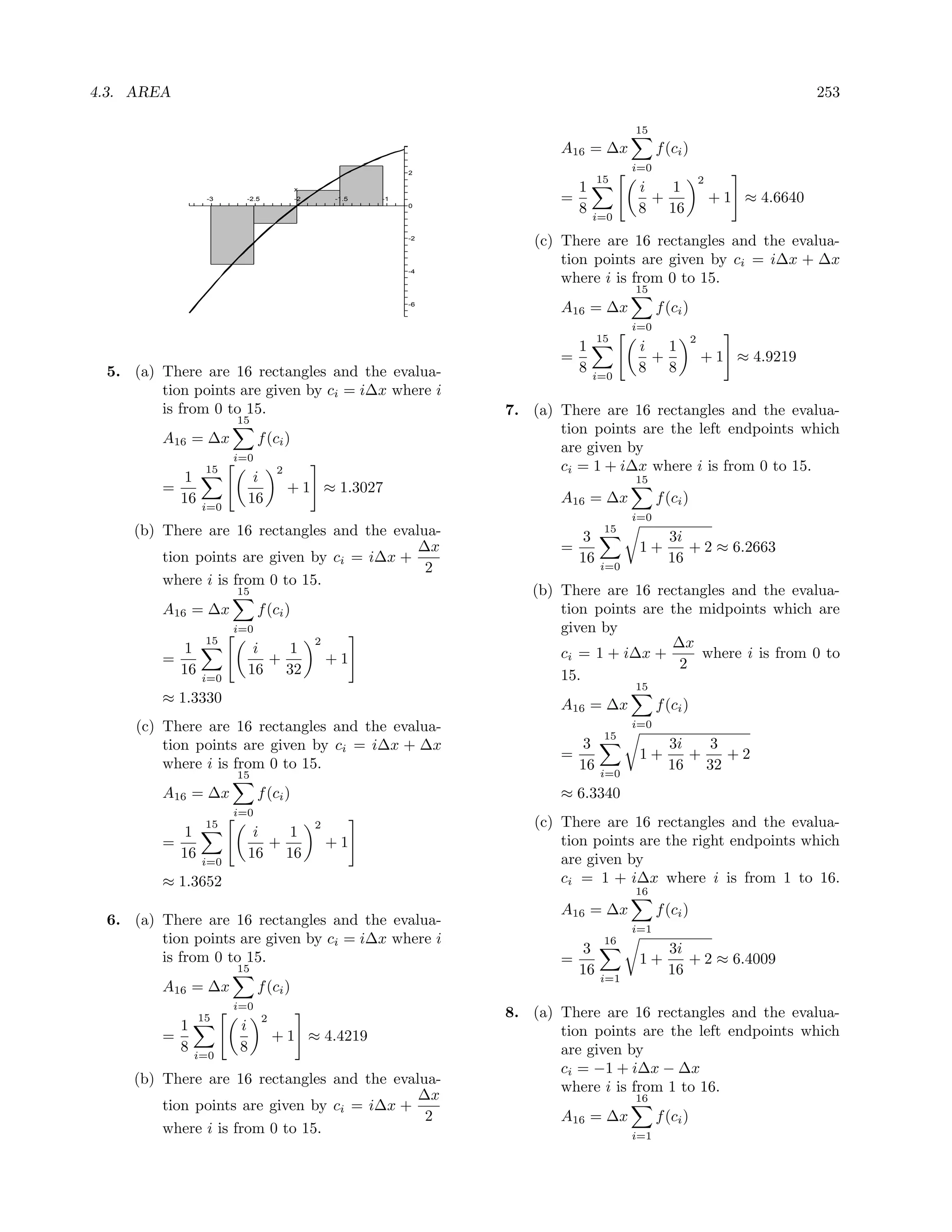

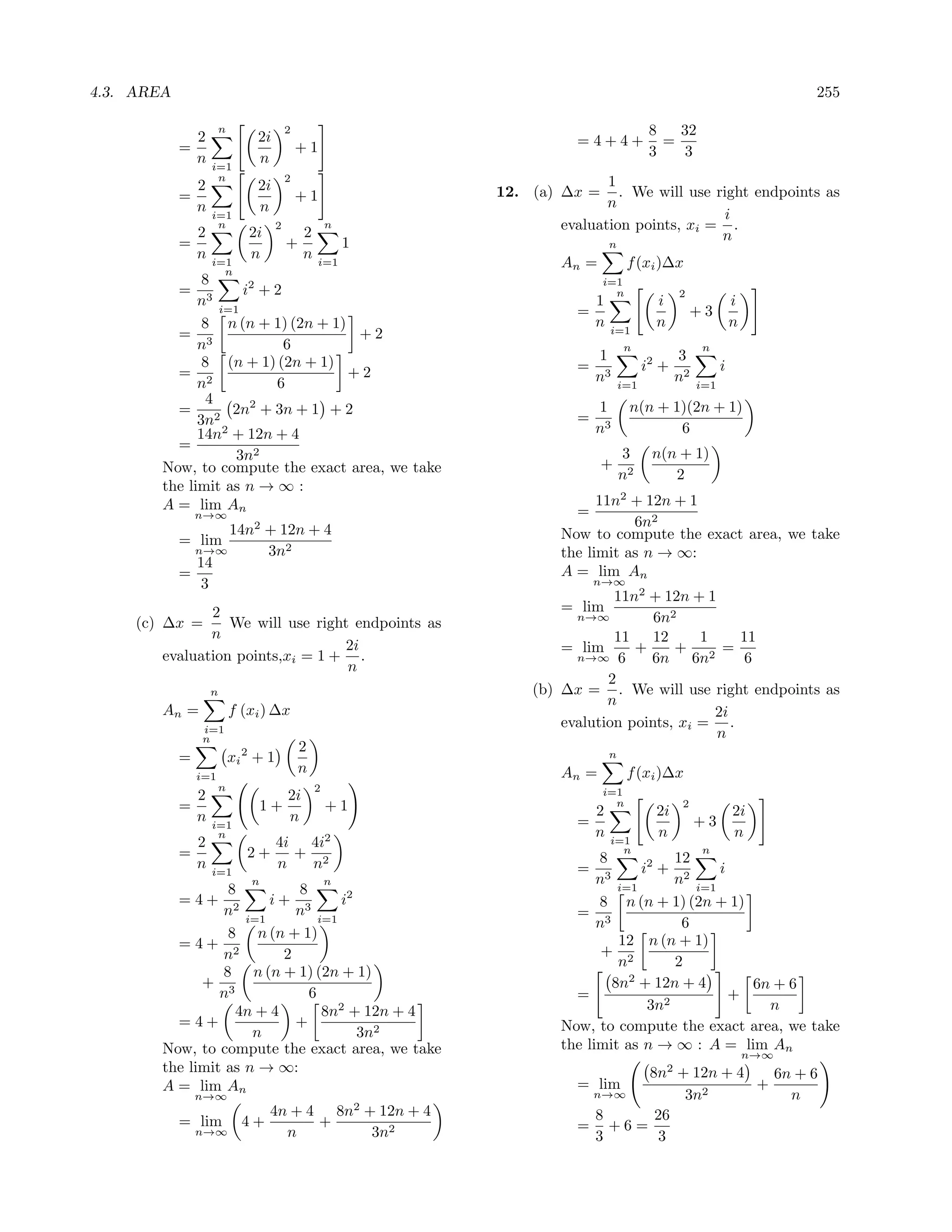
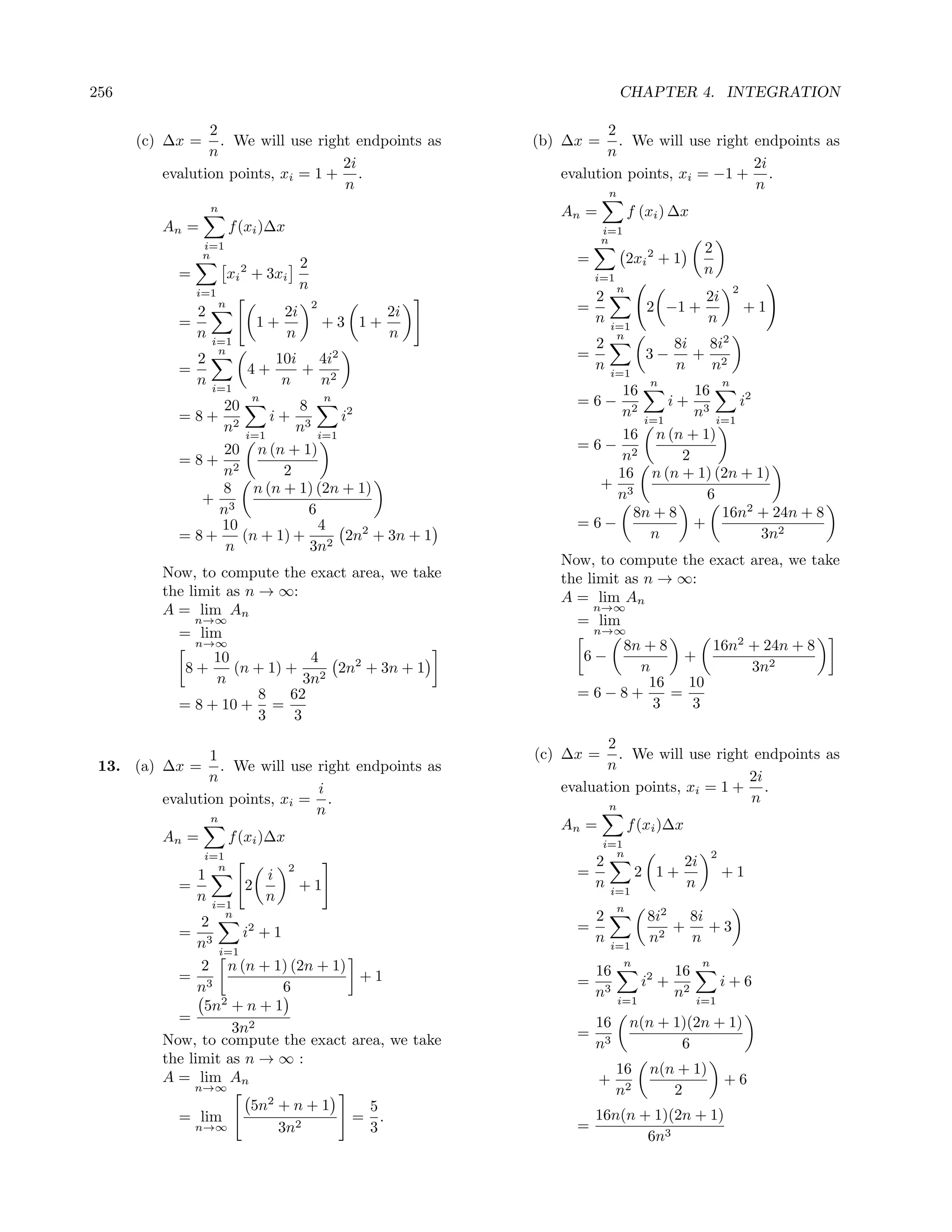
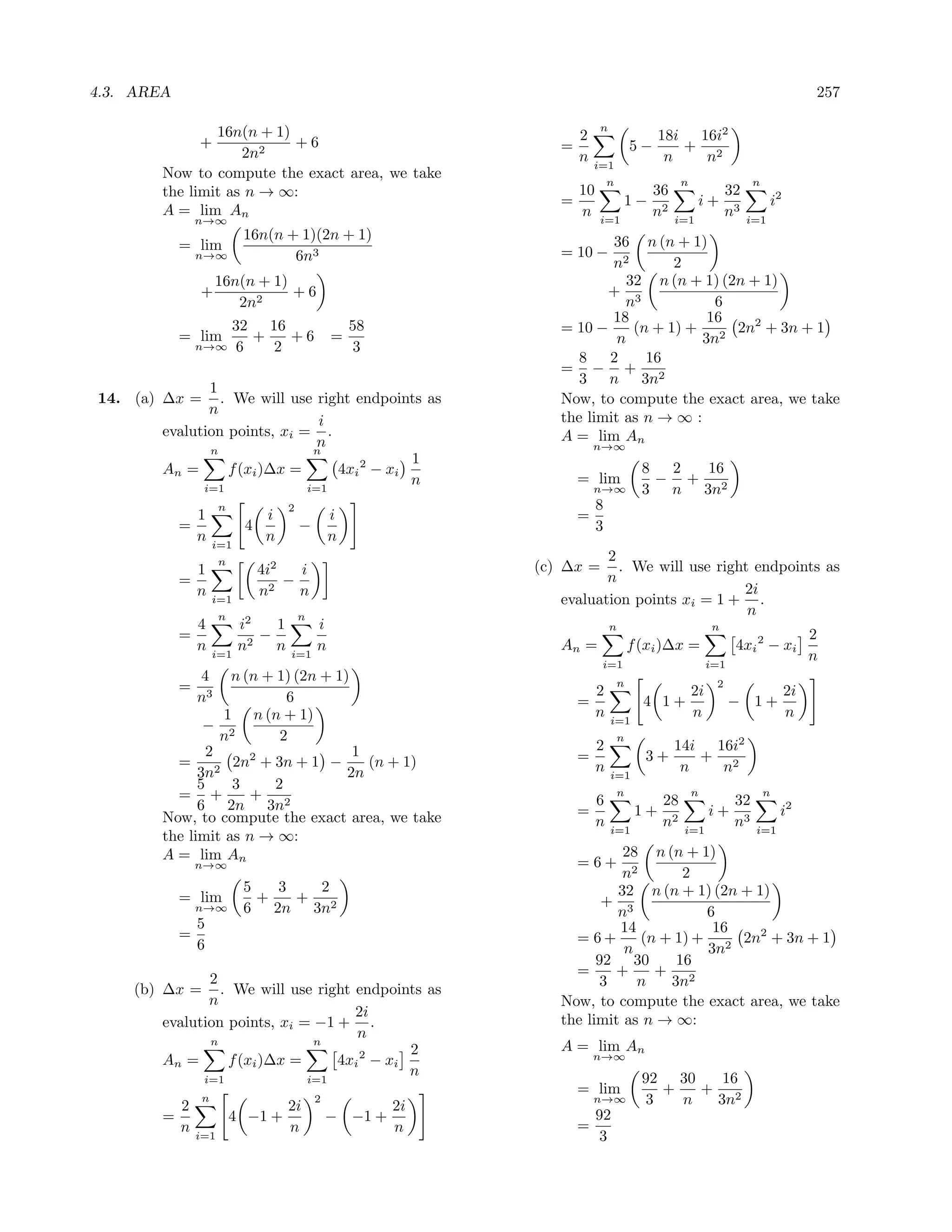
![258 CHAPTER 4. INTEGRATION
15. 20. Let L, M , and R be the values of the Riemann
n Left Midpoint Right sums with left endpoints, midpoints and right
Endpoint Endpoint endpoints. Let A be the area under the curve.
10 10.56 10.56 10.56 Then: L < A < M < R.
50 10.662 10.669 10.662
100 10.6656 10.6672 10.6656
250
500 10.6666 10.6667 10.6666
1000 10.6667 10.6667 10.6667 200
5000 10.6667 10.6667 10.6667
150
16. 100
n Left Midpoint Right
Endpoint Endpoint 50
10 0.91940 1.00103 1.07648 0
50 0.98421 1.00004 1.01563 1 1.5 2
x
2.5 3
100 0.99213 1.00001 1.00783
500 0.99843 1.00000 1.00157
21. Let L, M , and R be the values of the Riemann
1000 0.99921 1.00000 1.00079 sums with left endpoints, midpoints and right
5000 0.99984 1.00000 1.00016 endpoints. Let A be the area under the curve.
17. Then: R < A < M < L.
n Left Midpoint Right
Endpoint Endpoint 0.12
10 15.48000 17.96000 20.68000 0.1
50 17.4832 17.9984 18.5232
0.08
100 17.7408 17.9996 18.2608
500 17.9480 17.9999 18.0520 0.06
1000 17.9740 17.9999 18.0260 0.04
5000 17.9948 17.9999 18.0052
0.02
18.
n Left Midpoint Right 0
2 2.5 3 3.5 4
Endpoint Endpoint x
10 −2.20000 −2 −1.80000 22. Let L, M , and R be the values of the Riemann
50 −2.04000 −2 −1.96000 sums with left endpoints, midpoints and right
100 −2.02000 −2 −1.98000 endpoints. Let A be the area under the curve.
500 −2.00400 −2 −1.99600 Then: R < A < M < L.
1000 −2.00200 −2 −1.99800
5000 −2.00040 −2 −1.99960
250
19. Let L, M , and R be the values of the Riemann
sums with left endpoints, midpoints and right 200
endpoints. Let A be the area under the curve. 150
Then: L < M < A < R.
100
1000
50
800 0
1 1.5 2 2.5 3
x
600
400 23. There are many possible answers here. One
possibility is to use x = 1/6 on [0, 0.5] and
√
200 x = 23/6 on [0.5, 1].
0
2 2.5 3 3.5 4
24. There are many possible answers here. One
x possibility is to use x = 1/4 on [0, 0.5] and](https://image.slidesharecdn.com/ismetchapter4-111124021901-phpapp01/75/answers-tutor-8-19-2048.jpg)
![4.3. AREA 259
x = 25/36 on [0.5, 1]. 2
28. Consider interval[0, 2] , then ∆x = .
n
25. (a) We subdivide the interval [a, b] into n Use mid points as evaluation points, xi =
2(i−1)
equal subintervals. If you are located at n + 2i
n
a + (b − a)/n (the first right endpoint), .
2
then each step of distance ∆x takes you to
a new right endpoint. To arrive at the i-
n 2(i−1)
+ 2i 2
th right endpoint, you have to take (i − 1) A = lim n n
steps to the right of distance ∆x. There- n→∞
i=1
2 n
fore, n
2i − 2 + 2i 2
ci = a + (b − a)/n + (i − 1)∆x = a + i∆x. = lim
n→∞
i=1
2n n
(b) We subdivide the interval [a, b] into n Hence,
equal subintervals. The first evaluation n
1 √ 2
point is a + ∆x/2. From this evaluation A = lim √ 2i − 1 .
n→∞ n n
point, each step of distance ∆x takes you i=1
to a new evaluation point. To arrive at Assume
the i-th evaluation point, you have to take i = k + 1.
n−1
(i − 1) steps to the right of distance ∆x. 1 2
A= √ 2 (k + 1) − 1
Therefore, n n
k=0
ci = a + ∆x/2 + (i − 1)∆x n
1 √ 2
= a + (i − 1/2) ∆x, for i = 1, . . . , n. = √ 2k + 1
n n
k=1
26. (a) We subdivide the interval [a, b] into n hence,
n
equal subintervals. If you are located at a 1 √ 2
A1 = √ 2k + 1 .
(the first left endpoint), then each step of n n
k=1
distance ∆x takes you to a new left end-
point. To arrive at the i-th left endpoint, 4 2
you have to take (i − 1) steps to the right 2 i
29. U4 =
of distance ∆x. Therefore, 4 i=1
2
ci = a + (i − 1)∆x. 4
1 1 2
= i2 = 1 + 22 + 32 + 42
(b) We subdivide the interval [a, b] into n 8 8
i=1
equal subintervals. The first evaluation
4 2
point is a + ∆x/3. From this evaluation 30 2 i−1
= = 3.75 L4 =
point, each step of distance ∆x takes you 8 4 2
i=1
to a new evaluation point. To arrive at 4
the i-th evaluation point, you have to take 1 1 2
= i2 = 0 + 12 + 22 + 32
(i − 1) steps to the right of distance ∆x. 8 i=1
8
Therefore, 14
ci = a + ∆x/3 + (i − 1)∆x = = 1.75
8
= a + (i − 2/3) ∆x, for i = 1, . . . , n.
30. The function f (x) = x2 is symmetric on the
2
27. Consider interval [2, 4] , then ∆x = . two intervals [−2, 0] and [0, 2], so the upper
n sum U8 is just double the value of U4 as cal-
Use right endpoints as evaluation points,
2i culated in Exercise 35, and the same is for L8 .
xi = 2 + . The answers are
n
n U8 = 2 · 3.75 = 7.5, L8 = 2 · 1.75 = 3.5.
2i 2
A = lim 2+ n 2
n→∞
i=1
n n 2 2i
n 31. (a) Un =
√ i 2 n n
i=1
= lim 2 1+ 3 n
n→∞ n n 2
i=1 = i2
Hence, n
n i=1
√ i 2
A2 = lim 2 1+ . 3
n→∞ n n 2 n(n + 1)(2n + 1)
i=1 =
n 6](https://image.slidesharecdn.com/ismetchapter4-111124021901-phpapp01/75/answers-tutor-8-20-2048.jpg)
![260 CHAPTER 4. INTEGRATION
4 n(n + 1)(2n + 1) 24 (n − 1)2 n2 2
= = + (n)
3 n3 n4 4 n
4 1 1 4(n − 1)2
= 1+ 2+ = +2
3 n n n2
4 8
lim Un = (2) = 4(n2 − 2n + 1)
n→∞ 3 3 = +2
n2
n 2
2 2(i − 1) 8 4
(b) Ln = =6− + 2
n i=1
n n n
lim Ln = 6
3 n n→∞
2 2
= (i − 1) 33. Here, f (x) = a2 − x2 and interval is [−a, a].
n i=1 2a
3 n−1
Hence ∆x = .
2 n
= i2 Use right endpoints as evaluation points,
n i=1 2ai
xi = −a + .
3 n
2 (n − 1)(n)(2n − 1) n
=
n 6 An = f (xi )∆x
i=1
4 (n − 1)(n)(2n − 1) n
=
3 n3 = a2 − xi 2 ∆x
4 1 1 i=1
= 1− 2− n 2
3 n n 2ia 2a
= a2 − −a +
4 8 n n
lim Ln = (2) = i=1
n→∞ 3 3 n
4ia2 4i2 a2 2a
= −
i=1
n n2 n
n 3
2 2 3 n n
32. (a) Un = 0+ i +1 8a 8a3
n n = i− i2
i=1 n2 i=1
n3 i=1
n
2 2i
3 8a3 n (n + 1)
= +1 = 2
n n n 2
i=1
8a3 n (n + 1) (2n + 1)
2
4 n n − 3
= 3
i + 1 n 6
n 4a3 4a3
i=1 i=1 = (n + 1) − 3 2n2 + 3n + 1
n 3n
24 n2 (n + 1)2 2
= 4
+ (n) Now, to compute the exact area, we take the
n 4 n
limit as n → ∞:
4(n + 1)2 A = lim An
= +2 n→∞
n2
4a3 4a3
4(n2 + 2n + 1) = lim (n + 1) − 3 2n2 + 3n + 1
= +2 n→∞ n 3n
n2 8 4 3
8 4 = 4− a3 = a
=6+ + 2 3 3
n n 2 2
lim Un = 6 = (2a) a
n→∞ 3
n−1 3
2 2 34. Here,f (x) = ax2 and interval is [0, b].
(b) Ln = 0+ i +1
n i=0
n b
Hence ∆x = .
n−1 3
n
2 2i Use right endpoints as evaluation points, xi =
= +1 bi
n i=0
n .
n
4 n−1 n n
2
= i3 + 1 An = f (xi )∆x
n i=0 i=1 i=1](https://image.slidesharecdn.com/ismetchapter4-111124021901-phpapp01/75/answers-tutor-8-21-2048.jpg)

3 n
ab = (0.4 + 0.6 + 0.8 + 1.2 + 1.4 + 1.2 + 1.4 +
= i2 1.0)(0.2) = 1.60
n3 i=1
ab3 n (n + 1) (2n + 1)
= 3 39. A ≈ (0.2 − 0.1)(0.002) + (0.3 − 0.2)(0.004) +
n 6 (0.4 − 0.3)(0.008) + (0.5 − 0.4)(0.014) +
ab3 2 (0.6 − 0.5)(0.026) + (0.7 − 0.6)(0.048) +
= 2 2n + 3n + 1
6n (0.8 − 0.7)(0.085) + (0.9 − 0.8)(0.144) +
Now, to compute the exact area, we take the
(0.95 − 0.9)(0.265) + (0.98 − 0.95)(0.398) +
limit as n → ∞ :
(0.99 − 0.98)(0.568) + (1 − 0.99)(0.736) + 1/2 ·
A = lim An
n→∞ [(0.1 − 0)(0.002)
ab3 +(0.2−0.1)(0.004−0.002)+(0.3−0.2)(0.008−
= lim 2n2 + 3n + 1
n→∞ 6n2 0.004) + (0.4 − 0.3)(0.014 − 0.008) + (0.5 −
2ab3 ab3 1 0.4)(0.026 − 0.014) + (0.6 − 0.5)(0.048 −
= = = b ab2
6 3 3 0.026) + (0.7 − 0.6)(0.085 − 0.048) + (0.8 −
35. Using left hand endpoints: 0.7)(0.144 − 0.085) + (0.9 − 0.8)(0.265 −
L8 = [f (0.0)+f (0.1)+f (0.2)+f (0.3)+f (0.4)+ 0.144) + (0.95 − 0.9)(0.398 − 0.265) + (0.98 −
f (0.5) + f (0.6) + f (0.7)](0.1) 0.95)(0.568 − 0.398) + (0.99 − 0.98)(0.736 −
= (2.0 + 2.4 + 2.6 + 2.7 + 2.6 + 2.4 + 2.0 + 0.568) (1 − 0.99)(1 − 0.736)]
1.4)(0.1) = 1.81 ≈ 0.092615 The Lorentz curve looks like:
Right endpoints: 1
R8 = [f (0.1)+f (0.2)+f (0.3)+f (0.4)+f (0.5)+
f (0.6) + f (0.7) + f (0.8)](0.2) 0.8
= (2.4 + 2.6 + 2.7 + 2.6 + 2.4 + 2.0 + 1.4 +
0.6
0.6)(0.1) = 1.67
36. Using left hand endpoints: 0.4
L8 = [f ().0)+f (0.2)+f (0.4)+f (0.6)+f (0.8)+
0.2
f (1.0) + f (1.2) + f (1.4)](0.2)
= (2.0 + 2.2 + 1.6 + 1.4 + 1.6 + 2.0 + 2.2 + 0
2.4)(0.2) = 3.08 0.2 0.4 0.6 0.8 1
Right endpoints:
R8 = [f (0.2)+f (0.4)+f (0.6)+f (0.8)+f (1.0)+ 40. Obviously G = A1 /A2 is greater or equal to
f (1.2) + f (1.4) + f (1.6)](0.2) 0. From the above figure we see that the
= (2.2 + 1.6 + 1.4 + 1.6 + 2.0 + 2.2 + 2.4 + Lorentz curve is below the diagonal line y = x
2.0)(0.2) = 3.08 on the interval [0, 1], hence the area A1 ≤
37. Using left hand endpoints: the area A2 . Furthermore, A2 = the area of
L8 = [f (1.0)+f (1.1)+f (1.2)+f (1.3)+f (1.4)+ the triangle formed by the points (0, 0), (1, 0)
f (1.5) + f (1.6) + f (1.7)](0.1) and (1, 1), hence equal to 1/2. Now G =
= (1.8 + 1.4 + 1.1 + 0.7 + 1.2 + 1.4 + 1.82 + A1 /A2 = 2A1 . Using the date in Exercise 33,
2.4)(0.1) = 1.182 G ≈ 2 · 0.092615 = 0.185230.
Right endpoints:
R8 = [f (1.1)+f (1.2)+f (1.3)+f (1.4)+f (1.5)+
f (1.6) + f (1.7) + f (1.8)](0.1) 4.4 The Definite Integral
= (1.4 + 1.1 + 0.7 + 1.2 + 1.4 + 1.82 + 2.4 +
2.6)(0.1) = 1.262 1. We know that
3 n
x3 + x dx ≈ c3 + ci ∆x
i
38. Using left hand endpoints: 0 i=1
L8 = [f (1.0)+f (1.2)+f (1.4)+f (1.6)+f (1.8)+ xi + xi−1 3i
f (2.0) + f (2.2) + f (2.4)](0.2) Where ci = , xi = , n = 6.
2 n](https://image.slidesharecdn.com/ismetchapter4-111124021901-phpapp01/75/answers-tutor-8-22-2048.jpg)
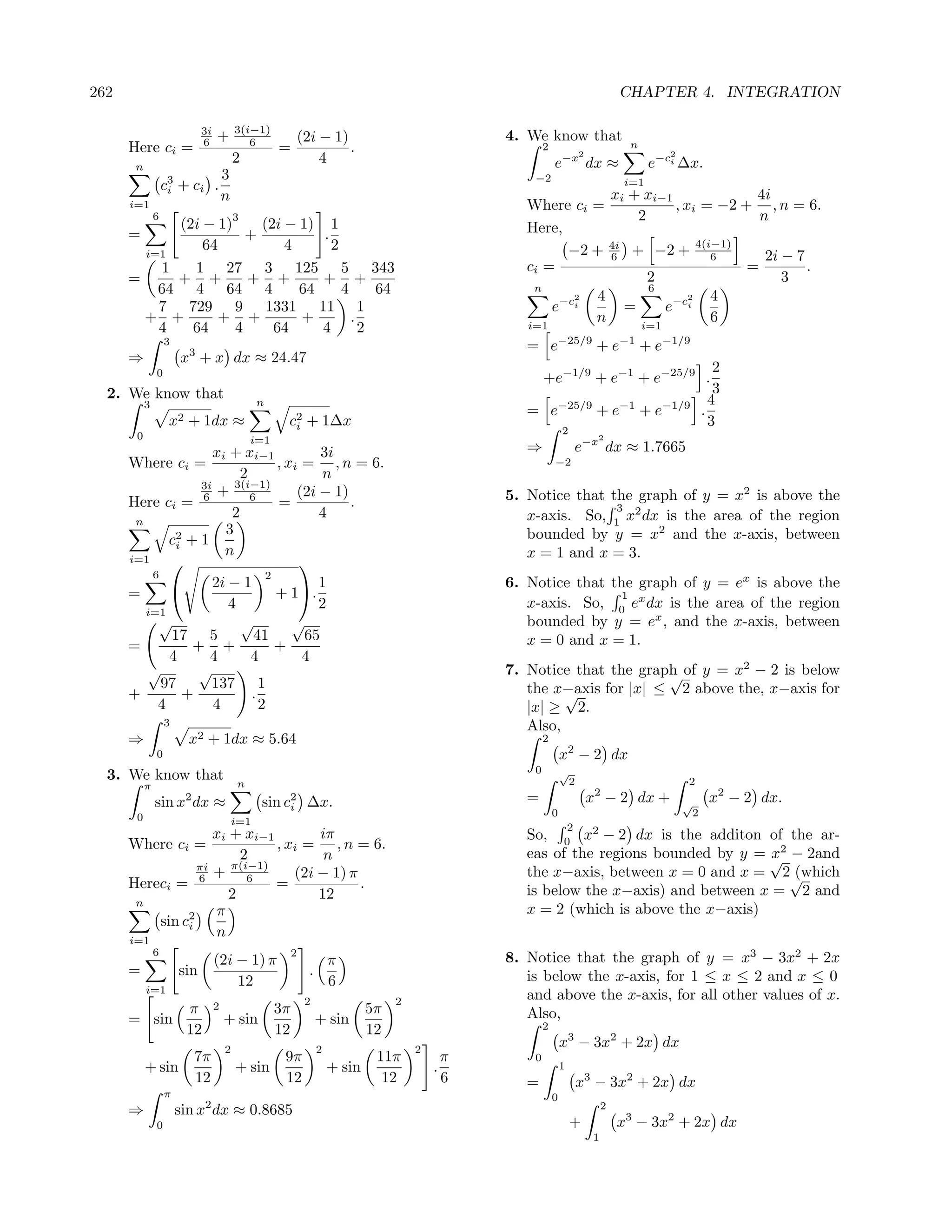
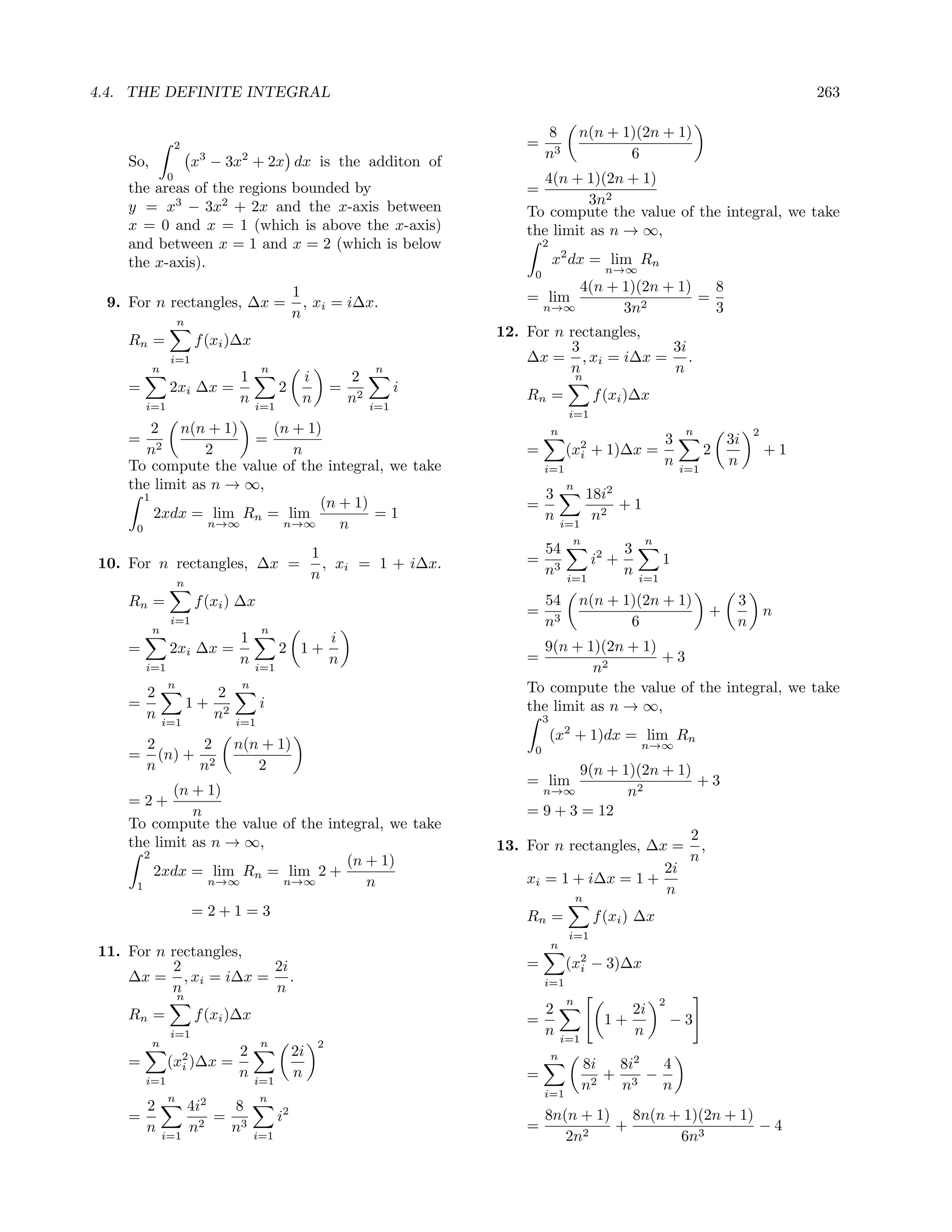
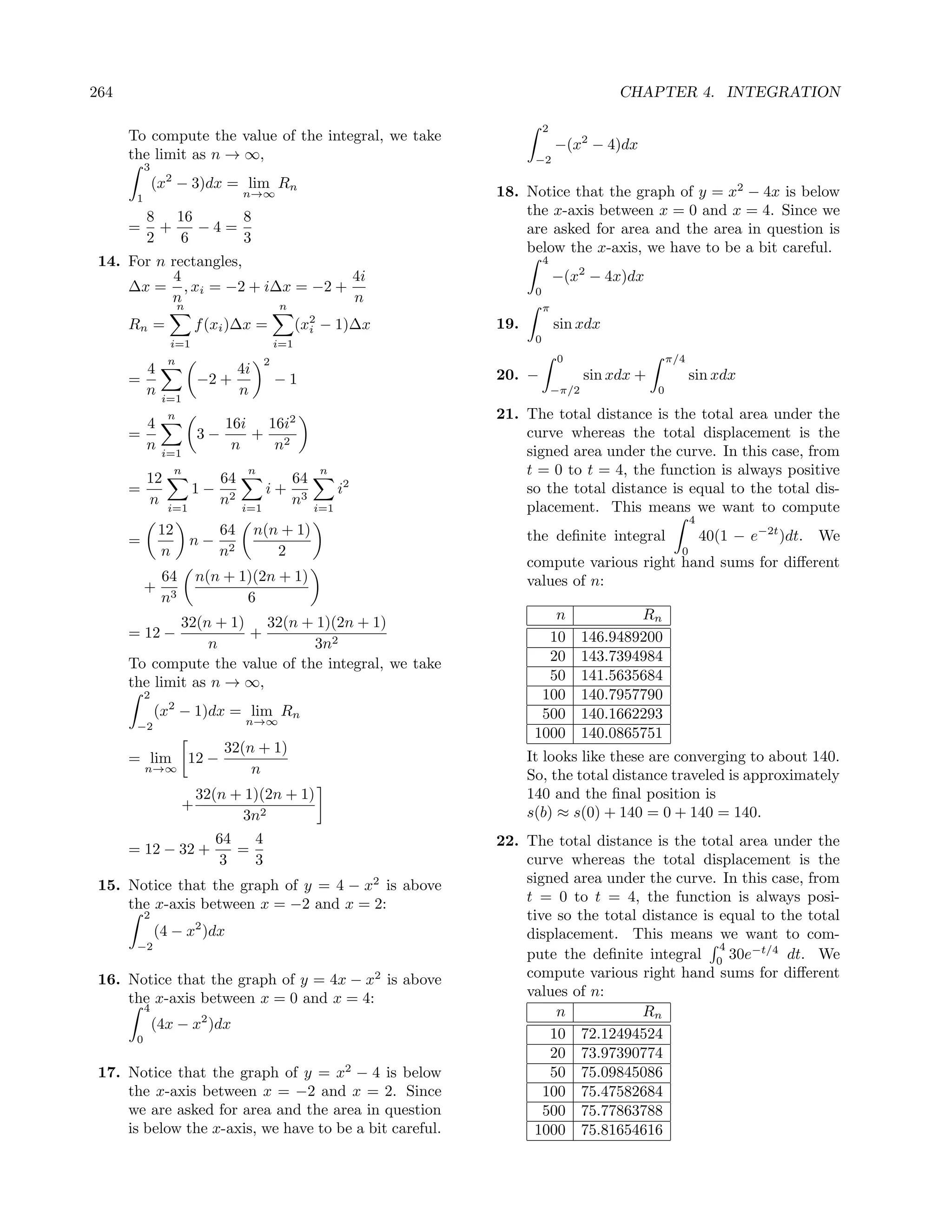
![4.4. THE DEFINITE INTEGRAL 265
n
It looks like these are converging to about 75.8. 1 i2 2i
= lim +
So, the total distance traveled is approximately n→∞ n n2 n
i=1
75.8 and the final position is
s(b) ≈ s(0) + 75.8 = −1 + 75.8 = 74.8. n(n + 1)(2n + 1) 2n(n + 1)
= lim +
n→∞ 6n3 n2
4
23. f (x)dx 2 7
= +2=
0 6 3
1 4
= f (x)dx + f (x)dx 1 3
0
1 4
1 27. fave = (x2 − 1)dx
3−1 1
= 2xdx + 4dx n 2
0 1 1 2i
1 = lim 1+ −1
n→∞ n n
2xdx is the area of a triangle with base i=1
0
1 and height 2 and therefore has area = 1 4i 4i2
1
= lim + 2
n→∞ n n n
2 (1)(2) = 1.
4
4dx is the area of a rectangle with base 3 4n(n + 1) 4n(n + 1)(2n + 1)
= lim +
1 n→∞ 2n2 6n3
and height 4 and therefore has area = (3)(4) =
4 10
12. =2+ =
Therefore 3 3
4
f (x)dx = 1 + 12 = 13 1
1
0 28. fave = (2x − 2x2 )dx
1−0 0
4 n 2
1 i i
24. f (x)dx = lim 2 −2
0
n→∞
i=1
n n n
2 4
n
= f (x)dx + f (x)dx 1 2i 2i2
0 2 = lim + 2
2 4 n→∞
i=1
n n n
= 2dx + 3xdx
0 2 2n(n + 1) 2n(n + 1)(2n + 1)
2 = lim +
2dx is the area of a square with base 2 and n→∞ 2n2 6n3
0 2 5
height 2 (it is, after all, a square) and therefore =1+ =
has area = 4. 3 3
4
3xdx is a trapezoid with height 3 and bases 29. The function f (x) = 3 cos x2 is decreasing on
2 [π/3, π/2]. Therefore, on this interval, the
6 and 12 and therefore has area (using the for-
maximum occurs at the left endpoint and is
mula in the front of the text)
1 f (π/3) = 3 cos(π 2 /9). The minimum occurs at
area = (6 + 12)(2) = 18.
2 the right endpoint and is f (π/2) = 3 cos(π 2 /4).
Therefore Using these to estimate the value of the inte-
4
gral gives the following inequality:
f (x)dx = 4 + 18 = 22 π/2
0 π π2
· (3 cos ) ≤ 3 cos x2 dx
4
6 4 π/3
1 π π2
25. fave = (2x + 1)dx ≤ · (3 cos )
4 0 6 9
n
1 4 8i π/2
= lim +1
4 n→∞ n n −1.23 ≤ 3 cos x2 dx ≤ 0.72
i=1
π/3
8n(n + 1)
= lim +1 2
n→∞ 2n2 30. The function f (x) = e−x is decreasing on
=4+1=5 [0, 1/2]. Therefore, on this interval, the maxi-
mum occurs at the left endpoint and is f (0) =
1 1. The minimum occurs at the right endpoint
1
26. fave = (x2 + 2x)dx and is f (1/2) = e−1/4 . Using these to estimate
1 0](https://image.slidesharecdn.com/ismetchapter4-111124021901-phpapp01/75/answers-tutor-8-26-2048.jpg)
![266 CHAPTER 4. INTEGRATION
the value of the integral gives the following in-
equality: We are interested in the value that is in the
√
1 −1/4 1/2
2 1 3−2 3
(e )≤ e−x dx ≤ (1) interval [−1, 1], so c = .
2 0 2 3
1/2 2 3 3
2
0.3894 ≤ e−x dx ≤ 0.5 35. (a) f (x)dx + f (x)dx = f (x)dx
0 0 2 0
√ 3 3 2
31. The function f (x) = 2x2 + 1 is increasing
(b) f (x)dx − f (x)dx = f (x)dx
on [0, 2]. Therefore, on this interval, the maxi- 0 2 0
mum occurs at the right endpoint and is f (2) =
2 1 1
3. The minimum occurs at the left endpoint 36. (a) f (x)dx + f (x)dx = f (x)dx
and is f (0) = 1. Using these to estimate the 0 2 0
value of the integral gives the following inequal- 2 3 3
ity: (b) f (x)dx + f (x)dx = f (x)dx
2 −1 2 −1
(2)(1) ≤ 2x2 + 1dx ≤ (2)(3) 3
0
2 37. (a) (f (x) + g (x)) dx
2≤ 2x2 + 1dx ≤ 6 1
3 3
0
= f (x) dx + g (x) dx
3 1 1
32. The function f (x) = 3 is decreasing = 3 + (−2) = 1
x +2
on [−1, 1]. Therefore, on this interval, the
3
maximum occurs at the left endpoint and is
(b) (2f (x) − g (x)) dx
f (−1) = 3. The minimum occurs at the right 1
endpoint and is f (1) = 1. Using these to esti- 3 3
mate the value of the integral gives the follow- =2 f (x) dx − g (x) dx
1 1
ing inequality: = 2 (3) − (−2) = 8
1
3
(2)(1) ≤ dx ≤ (2)(3)
−1 x3 + 2 3
1
3 38. (a) (f (x) − g (x)) dx
2≤ 3+2
dx ≤ 6 1
−1 x 3 3
= f (x) dx − g (x) dx
33. We are looking for a value c, such that 1 1
2
1 = 3 − (−2) = 5
f (c) = 3x2 dx
2−0 0
2 3
Since 3x2 dx = 8, we want to find c so that (b) (4g (x) − 3f (x)) dx
0 1
2 3 3
f (c) = 4 or, 3c = 4
Solving this equation using the quadratic for- =4 g (x) dx − 3 f (x) dx
1 1
2 = 4 (−2) − 3 (3) = −17
mula gives c = ± √
3
We are interested in the value that is in the
2 39. (a)
interval [0, 2], so c = √ .
3
3
34. We are looking for a value c, such that
1
1
f (c) = (x2 − 2x)dx 2
1 − (−1) −1
1
2
Since (x2 − 2x)dx = , we want to find c 1
−1 3
1 2 1
so that f (c) = or, c − 2c =
3 3 1 2 3
Solving this equation using the quadratic for-
√
3±2 3
mula gives c =
3](https://image.slidesharecdn.com/ismetchapter4-111124021901-phpapp01/75/answers-tutor-8-27-2048.jpg)
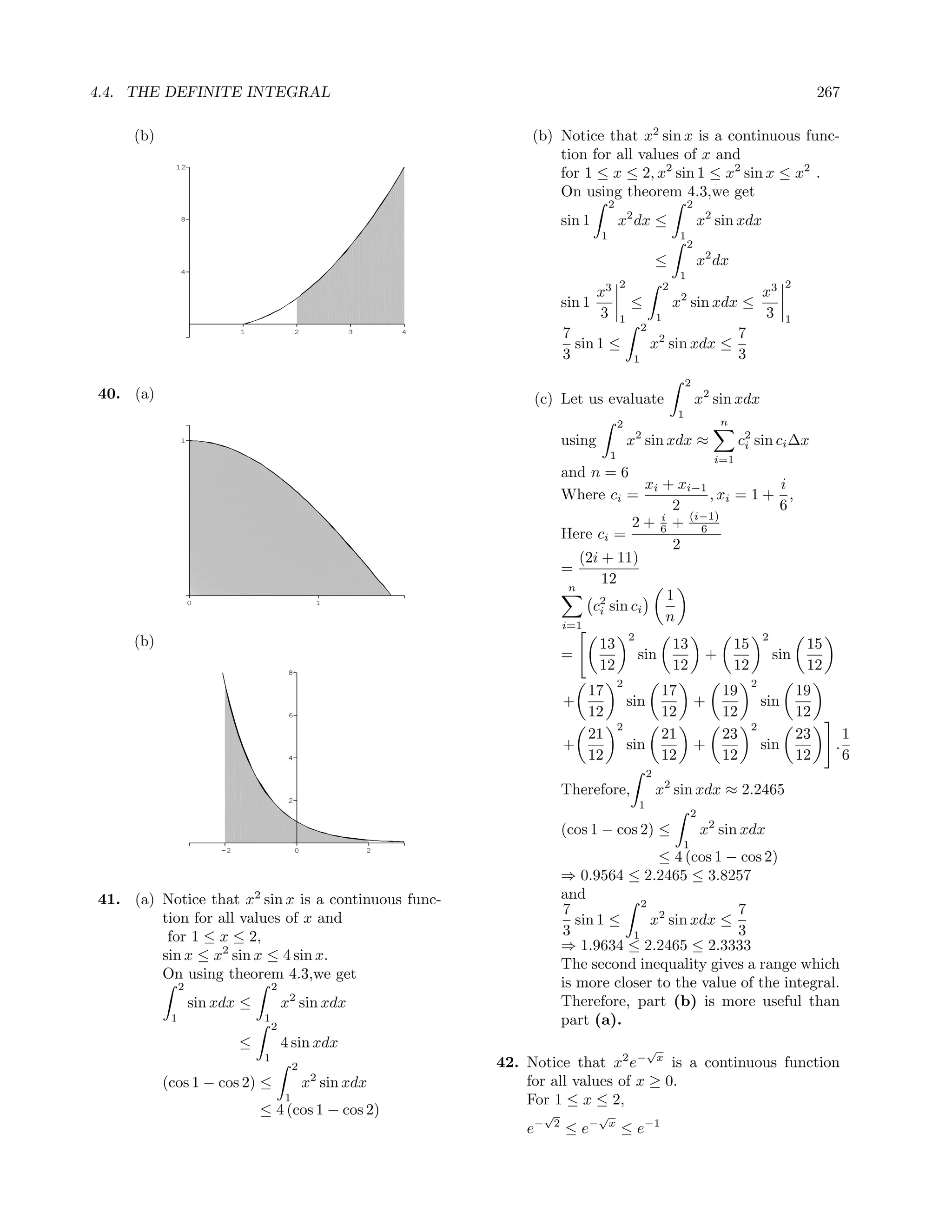
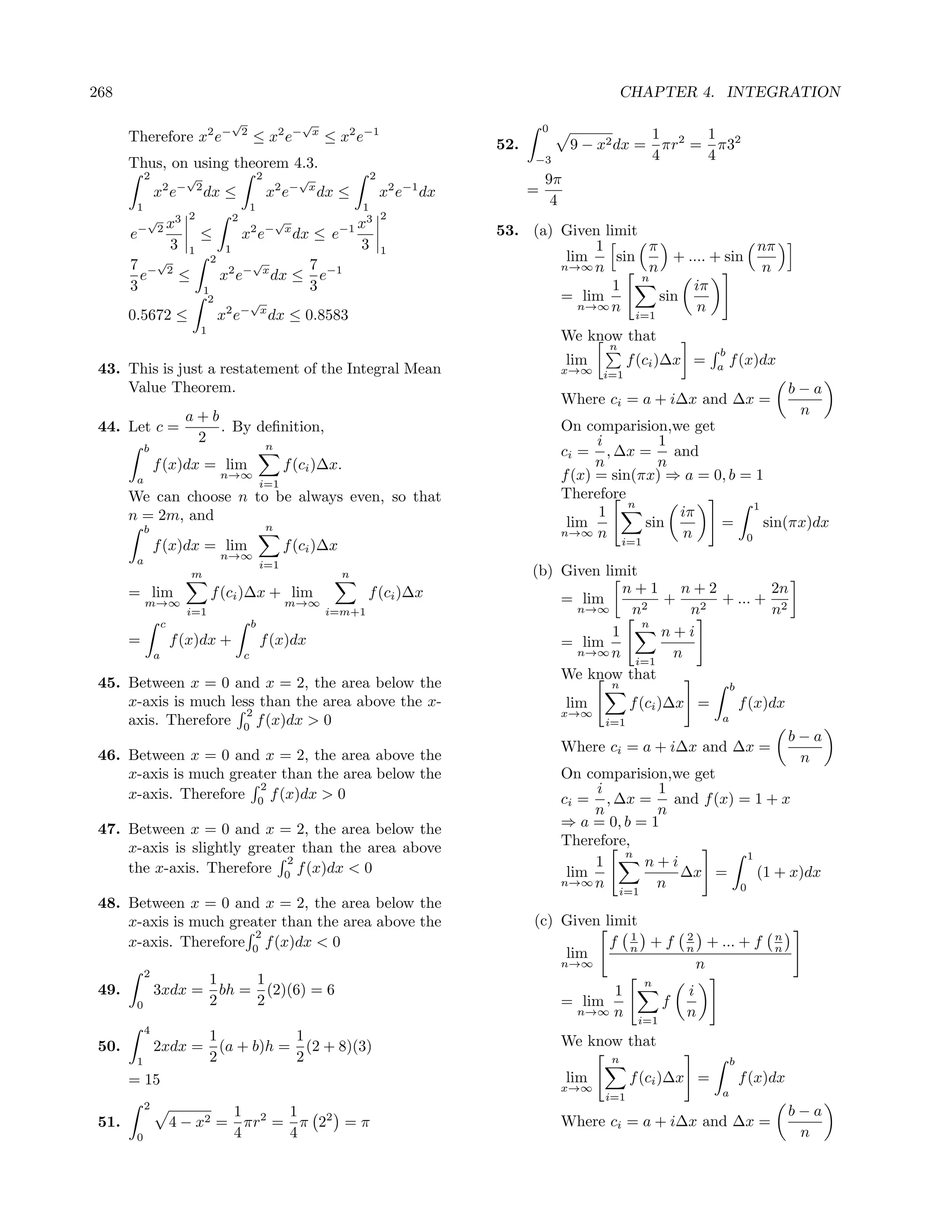
![4.4. THE DEFINITE INTEGRAL 269
On comparision,we get per month), the total number of births from
i 1 time t = 0 to t = 12 is given by the integral
ci = and ∆x = n 12
n
⇒ a = 0, b = 1 b(t)dt.
Therefore, 0
n 1
Similarly, the total number of deaths from time
1 i t = 0 to t = 12 is given by the integral
lim f = f (x)dx 12
n→∞ n n 0
i=1 a(t)dt.
0
b
1 Of course, the net change in population is the
54. f (x)dx = v number of birth minus the number of deaths:
b−a a
b Population Change
f (x)dx = v(b − a) = Births − Deaths
a
and 12 12
c
1 = b(t)dt − a(t)dt
f (x)dx = w 0 0
c−b b
c 12
f (x)dx = w(c − b) = [b(t) − a(t)]dt.
b 0
The average value of f over [a, c] is By graphing b(t) and a(t) we see that their
c
1 graphs intersect 9 times, at
f (x)dx
c−a a t ≈ 38.5, 40.1, 44.4, 46.9, 50.2, 53.6,
b c
56.1, 60.5, 61.9.
1 This tells us that we have b(t) > a(t) on the
= f (x)dx + f (x)dx
c−a a b intervals
1 (0, 38.5), (40.1, 44.4), (46.9, 50.2),
= [v(b − a) + w(c − b)] (53.6, 56.1), (60.5, 61.9).
c−a
v(b − a) + w(c − b) The maximum population will occur when t =
= 50.2.
c−a
55. Since b(t) represents the birthrate (in births 404
per month), the total number of births from 402
time t = 0 to t = 12 is given by the integral 400
12
0
b(t) dt. 398
Similarly, the total number of deaths from time
t = 0 to t = 12 is given by the integral 396
12
0
a(t) dt. 394
Of course, the net change in population is the 392
number of birth minus the number of deaths: 390
Population Change 0 10 20 30
t
40 50 60 70
= Births − Deaths
12 12 57. From P V = 10 we get P (V ) = 10/V . By
= b(t) dt − a(t) dt definition,
0 0 4 4
10
12 P (V ) dV = dV
= [b(t) − a(t)] dt. 2 2 V
n
0 2 10
Next we solve the inequality = ·
n 2 + 2i
410 − 0.3t > 390 + 0.2t i=1 n
20 > 0.5t then t < 40 months . An estimate of the value of this integral is
Therefore b(t) > a(t) when t < 40 months. setting n = 100, and then the integral ≈ 6.93
The population is increasing when the birth
rate is greater than the death rate, which is 58. The average temperature over the year is
12
during the first 40 month. After 40 months, 1 π
64 − 24 cos t dt. If you look at the
the population is decreasing. The population- 12 0 6
would reach a maximum at t = 40 months. graphs T (t) and f (t) = 64 you should be able
to see that the area under T (t) and f (t) be-
56. Since b(t) represents the birthrate (in births tween t = 0 to t = 12 are equal. This means](https://image.slidesharecdn.com/ismetchapter4-111124021901-phpapp01/75/answers-tutor-8-30-2048.jpg)
![270 CHAPTER 4. INTEGRATION
that the average temperature is 64. 61. Delivery is completed in time Q/p, and since
in that time Qr/p items are shipped, the in-
ventory when delivery is completed is
80
Qr r
Q− =Q 1− .
p p
60
The inventory at any time is given by
(p − r)t for t ∈ 0, Q
40 p
g(t) =
Q − rt for t ∈ Q , Q
p r
20
The graph of g has two linear pieces. The av-
erage value of g over the interval [0, Q/r] is the
0
0 2 4 6 8 10 12 area under the graph (which is the area of a
t
triangle of base Q/r and height Q(1 − r/p)) di-
vided by the length of the interval (which is the
59. Since r is the rate at which items are shipped, base of the triangle). Thus the average value
rt is the number of items shipped between time of the function is (1/2)bh divided by b, which
0 and time t. Therefore, Q − rt is the num- is
ber of items remaining in inventory at time t. (1/2)h = (1/2)Q(1 − r/p).
Since Q − rt = 0 when t = Q/r, the formula This time the total cost is
is valid for 0 ≤ t ≤ Q/r. The average value of D Q r
f (Q) = c0 + cc (1 − )
f (t) = Q − rt on the time interval [0, Q/r] is Q 2 p
Q/r r
1 c0 D cc (1 − p )
f (t)dt f (Q) = − +
Q/r − 0 0 Q2 2
r Q/r c0 D cc r
= (Q − rt)dt f (Q) = 0 gives 2 = (1 − )
Q 0 Q 2 p
Q/r
r 1
= Qt − rt2 2c0 D
Q 2 Q= .
0 cc (1 − r/p)
r Q2 r Q2 The order size to minimize the total cost is
= −
Q r 2 r2 2c0 D
Q= .
r Q2 Q cc (1 − r/p)
= = .
Q 2r 2 62. Use the result from Exercise 60,
2c0 D
D Q Q=
60. f (Q) = c0 + cc cc
Q 2
c0 D cc 2(50, 000)(4000)
f (Q) = − 2 + = ≈ 324.44.
Q 2 3800
Setting f (Q) = 0 gives Since this quantity already takes advantage of
c0 D cc largest possible discount, the order size that
=
Q2 2 minimizes the total cost is about 324.44 items.
2c0 D
Q = . This is the right answer of Q 63. The maximum of
cc F (t) = 9 − 108 (t − 0.0003)2
minimizing the total cost f (Q), since when the
occurs when 108 (t − 0.0003)2 reaches its mini-
value of Q is very small, the value of D/Q
mum, that is, when t = 0.0003. At that time
will get very big, and when the value of Q
F (0.0003) = 9 thousand pounds.
is very small, the value of Q/2 will get very
We estimate the value of
big. This means that the function f (Q) is de-
0.0006
creasing on the interval [0, 2c0 D/cc ] and in- [9 − 108 (t − 0.0003)2 ] dt using midpoint
creasing on the interval [ 2c0 D/cc , ∞]. When 0
sum and n = 20, and get m∆v ≈ 0.00360 thou-
Q = 2c0 D/cc ,
sand pound-seconds, so ∆v ≈ 360 ft per sec-
2c0 D
D c0 D cc Q ond.
c0 = = cc = cc .
Q 2c0 D 2 2
cc 64. The impulse-momentum equation of Prob-](https://image.slidesharecdn.com/ismetchapter4-111124021901-phpapp01/75/answers-tutor-8-31-2048.jpg)
![4.5. THE FUNDAMENTAL THEOREM OF CALCULUS 271
π/2
lem 65 gives 5∆v π/2
0.4 10. 3 csc x cot xdx = (−3 csc x)
= (1000 − 25, 000(t − 0.2)2 ) dt π/4
π/4
0 √
0.4 = −3 + 3 2
= (−25000t2 + 10000t) dt
0 π/4
π/4
Using a midpoint sum and n = 20 gives an
11. (sec t tan t) dt = sec t
approximation for this integral of 267.0. This 0
means 5∆v ≈ 267 and ∆v ≈ 53.4 m/s √ 0
= 2−1
π/4
π/4
4.5 The Fundamental Theorem 12. 2
sec tdt = tan t =1
of Calculus 0
0
2 2 1/2
1/2
1. (2x − 3)dx = x2 − 3x = −2 3
13. √ dx = 3sin−1 x
0 0 0 1 − x2 0
3
x3
3 π π
2. 2
x − 2 dx = − 2x =3 =3 −0 =
3 6 2
0 0
1 1
1 1 4
3 x4 14. dx = 4 arctan x = 2π
3. x + 2x dx = + x2 =0 1 + x2
−1 4 −1
−1 −1
2 4
t−3
4. x3 + 3x − 1 dx 15. dt
0 1 t
2 4
x4 3x2 4
= − −x = −4 = 1 − 3t −1
dt = (t − 3 ln |t|)
4 2 0 1 1
4
= 3 − 3 ln 4
√ 3
5. x x+ dx 4 4
1 x t3 16
16. t (t − 2) dt = − t2 =
2 5/2
4 0 3 0 3
= x + 3 log x
5 1 t 2
t
2 2 17. ex/2 dx = (ex ) = et − 1
= · 32 + 3 log 4 − .1 − 3 log 1 0 0
5 5
62 t
= + 3 log 4 18. sin2 x + cos2 x dx
5 0
2 2 t t
2 2
6. 4x − dx = 2x2 + =5 = 1dx = (x) =t
1 x2 x 1 0 0
1 1
6e−3x 19. The graph of y = 4 − x2 is above the x-axis
7. 6e−3x + 4 dx =
+ 4x
0 −3 0
over the interval [−2, 2].
2 2
2 2 x3 32
=− 3 +4+2−0=− 3 +6 4 − x2 dx = 4x − =
e e −2 3 −2 3
2
e2x − 2e3x
8. dx 20. The graph of y = x2 − 4x is below the x-axis
0 e3x
2 2 over the interval [0, 4].
= e−x − 2 dx = −e−x − 2x 4
x3
4
32
0 0 − x2 − 4x dx = − + 2x2 =
1 0 3 3
=− 2 −3 0
e
π
π 21. The graph of y = x2 is above the x-axis over
9. (2 sin x − cos x)dx = −2 cos x − sin x the interval [0, 2] .
2 2
π/2
π/2 x3 8
=3 x2 dx = =
0 3 0 3](https://image.slidesharecdn.com/ismetchapter4-111124021901-phpapp01/75/answers-tutor-8-32-2048.jpg)
![272 CHAPTER 4. INTEGRATION
0 sin x
22. The graph of y = x3 is above the x-axis over
32. f (x) == t2 + 4 dt + t2 + 4 dt
the interval 3x 0
[0, 3] . 3x sin x
3 3 =− t2 + 4 dt + t2 + 4 dt
x4 81
x3 dx = = 0
d
0
0 4 0 4 f (x) = − 9x2 + 4 (3x)
dx
23. The graph of y = sin x is above the x-axis over d
+ sin2 x + 4 (sin x)
the interval [0, π] . dx
2 2
π π = −27x − 12 + sin x cos x + 4 cos x
sin xdx = − cos x =2
0 0 33. s (t) = 40t + cos t + c,
s (0) = 0 + cos 0 + c = 2
24. The graph of y = sin x is below the x-axis over
so therefore c = 1 and s (t) = 40t + cos t + 1.
the interval − π , 0 and above the x-axis over
2
the interval 0, π . Hence we need to compute
4 34. s (t) = 10et + c,
two seperate integrals and add them together: s (0) = 10 + c = 2
0 π/4 so therefore c = −8 and s (t) = 10e−t − 8.
− sin xdx + sin xdx
−π/2 0 t2
1 1 35. v (t) = 4t − + c1 ,
=1+ 1− √ =2− √ . 2
2 2 v (0) = c1 = 8
25. f (x) = x2 − 3x + 2 t2
so therefore c1 = 8 and v (t) = 4t − + 8.
2
t3
26. f (x) = x2 − 3x − 4 s (t) = 2t2 − + 8t + c2 ,
6
s (0) = c2 = 0
2 2 d
27. f (x) = e−(x ) + 1 x2 t3
dx so therefore c2 = 0 and s (t) = 2t2 − + 8t.
4
= 2x e−x + 1 6
t3
36. v (t) = 16t − + c1 ,
28. f (x) = − sec x 3
v (0) = c1 = 0
0 2−x
so therefore c1 = 0 and
29. f (x) = sin t2 dt + sin t2 dt
ex 0
t3
v (t) = 16t − .
d x 3
f (x) = − sin e2x (e ) t4
dx 2
s (t) = 8t − + c2 ,
2 d 12
+ sin (2 − x) (2 − x) s (0) = c2 = 30
dx
x 2x 2
= −e sin e − sin (2 − x) t4
so therefore c2 = 30 and s (t) = 8t2 − + 30.
0 xex
12
2t
30. f (x) = e dt + e2t dt 37. Let w (t) be the number of gallons in the tank
2−x 0
at time t.
d
f (x) = −e2(2−x) (2 − x) (a) The water level decreases if w (t) =
dx
x d f (t) < 0 i.e. if f (t) = 10 sin t < 0, for
+ e2(xe ) (xex )
dx x which π < t < 2π.
= e4−2x + e2xe (xex + ex ) Alternatively, the water level increases if
w (t) = f (t) > 0 i.e. if f (t) = 10 sin t >
0 x3
0, for which 0 < t < π.
31. f (x) = sin (2t) dt + sin (2t) dt
x2 0 (b) Now,we start with
d
f (x) = − sin 2x2 x2 w (t) = 10 sin t
dx π π
d
+ sin 2x3 x3 Therefore, w (t) dt = 10 sin tdt
dx 0
π
0
= −2x sin 2x2 + 3x2 sin 2x3 w (π) − w (0) = − 10 cos t|0](https://image.slidesharecdn.com/ismetchapter4-111124021901-phpapp01/75/answers-tutor-8-33-2048.jpg)

![274 CHAPTER 4. INTEGRATION
51. If you look at the graph of 1/x2 , it is obvious (b) is improper since the point x = 3 lies in
that there is positive area between the curve 1
the interval [0, 4], and is not defined
and the x-axis over the interval [−1, 1]. In ad- (x − 3)2
dition to this, there is a vertical asymptote in at x = 3. The integral in part (c) is improper
the interval that we are integrating over which since the point x = π/2 lies in the interval
should alert us to a possible problem. [0, 2], and sec x is not defined at x = π/2.
The problem is that 1/x2 is not continuous 1 3
on [−1, 1] (the discontinuity occurs at x = 0) 55. fave = x2 − 1 dx
3−1 1
and that continuity is one of the conditions in 3
1 x3 10
the Fundamental Theorem of Calculus, Part = −x =
I(Theorem 4.1). 2 3 1 3
1
1
50 56. fave = 2x − 2x2 dx
1−0 0
1
40 2x3 1
= x2 − =
3 0 3
30
π/2
y
1
20 57. fave = cos xdx
π/2 − 0 0
2 π/2 2
10 = (sin x)|0 =
π π
2
0
1
ex dx
-1 -0.5 0 0.5 1
x 58. fave =
2−0 0
2
52. If you look at the graph of sec2 x, it is obvious 1 x
= (e )
that there is positive area between the curve 2 0
and the x-axis over the interval [0, π]. In ad- 1 2
= e −1
dition to this, there is a vertical asymptote in 2
the interval that we are integrating over which 59. (a) Using the Fundamental Theorem of Cal-
should alert us to a possible problem. The culus, it follows that an antiderivative of
problem is that sec2 x is not continuous on [0, π] 2
x
2
and that continuity is one of the conditions in e−x is e−t dt where a is a constant.
a
the Fundamental Theorem of Calculus, Part I
(b) Using the Fundamental Theorem of Cal-
(Theorem 4.1).
culus, it follows that an antiderivative of
x
10 sin x2 + 1 is sin t2 + 1dt where a
a
8
is a constant.
y
6
60. It may be observed that f is piecewise contin-
uous over its domain.
4 For 0 < x ≤ 4,
x x
2
g(x) = f (t) dt = t2 + 1 dt
0 0
x
t3 x3
-1
0
0 1 2 3 4 = +t = +x
x 3 0 3
Now, for x > 4
x
53. The integrals in parts (a) and (c) are improper, g(x) = f (t) dt
0
because the integrands have asymptotes at one 4 x
of the limits of integration. The Fundamental = f (t) dt + f (t) dt
0 4
Theorem of Calculus applies to the integral in 4 x
part (b). = t2 + 1 dt + t3 − t dt
0 4
4 x
54. The Fundamental Theorem of Calculus applies t3 4
t t2
to the integral in part (a). The integral in part
= +t + −
3 0 4 2 4](https://image.slidesharecdn.com/ismetchapter4-111124021901-phpapp01/75/answers-tutor-8-35-2048.jpg)
![4.5. THE FUNDAMENTAL THEOREM OF CALCULUS 275
43 x4 x2 44 42 1
= +4 + − − + f (1) = t2 − 3t + 2 dt
3 4 2 4 2 0
x4 x2 92 t3 3t2
1
5
= − − = − + 2t =
4 2 3 3 2 6
x3 0
+x for 0 < x ≤ 4 2
g (x) = x4 3 x2 92 f (2) = 2
t − 3t + 2 dt
4 − 2 − 3 for 4 < x
0
Consider 2
g (4 + h) − g (4) t3 3t2 2
g (4) = lim = − + 2t =
h→0 h 3 2 0 3
4+h 4 Hence f (x) has a local maximum at the
1
= lim f (t) dt − f (t) dt 5
h→0 h 0 0
point 1, and local minimum at the point
6
4+h
1 2
= lim f (t) dt. 2, .
h→0 h 4 3
The Right Hand Limit: x u
1 4+h 62. g (x) = f (t) dt du
lim+ f (t) dt 0 0
h→0 h 4 x
1 4+h 3 g (x) = f (t) dt
= lim t − t dt 0
h→0+ h 4 g (x) = f (x)
4+h
1 t4 t2 A zero of f corresponds to a zero of the second
= lim −
h→0+ h 4 2 4 derivative of g (possibly an inflection point of
1 (4 + h)
4
(4 + h)
2
44 42 g).
= lim+ − − +
h→0 h 4 2 4 2 63. When a < 2 or a > 2, f is continuous. Using
1 h4 47h2 the Fundamental Theorem of Calculus,
= lim + 4h3 − + 60h
h→0+ h 4 2 lim F (x) − F (a)
x→a
h3 47h = lim [F (x) − F (a)]
= lim+ + 4h2 − + 60 = 60. x→a
h→0 4 2 x a
Now, the Left Hand Limit: = lim f (t) dt − f (t) dt
x→a 0 0
1 4+h x
lim− f (t) dt = lim f (t) dt = 0
h→0 h 4 x→a a
1 4+h 2 When a = 2,
= lim t + 1 dt x x
h→0− h 4
4+h
lim f (t) dt = lim tdt
1 t3 x→a− a
x
x→2− 2
= lim +t t2 2
x 22
h→0− h 3 4 = lim = lim− − =0
3 x→2− 2 x→2 2 2
1 (4 + h) 43 2
x
= lim− +4+h− −4
h→0 h 3 3 and lim+ f (t) dt
x→a a
1 h3 + 12h2 + 48h + 64 64 x
= lim +h− = lim+ (t + 1) dt
h→0+ h 3 3 x→2 2
h2 t 2 x
= lim+ + 4h + 17 = 17. = lim+ +t
h→0 3 x→2 2 2
Therefore, g (4) doesn’t exist though f (4) x2 22
= lim +x− −2
exists. Therefore g (x) = f (x) is not true for x→2+ 2 2
all x ≥ 0. =0
Thus, for all value of a,
lim F (x) − F (a) = 0
x→a
61. f (x) = x2 − 3x + 2. lim F (x) = F (a)
x→a
Setting f (x) = 0, we get (x − 1) (x − 2) = 0 Thus, F is continuous for all x. However, F (2)
which implies x = 1, 2. does not exist, which is shown as follows:
> 0 when t < 1 or t > 2 F (2 + h) − F (2)
f (x) = F (2) = lim
< 0 when 1 < t < 2 h→0 h](https://image.slidesharecdn.com/ismetchapter4-111124021901-phpapp01/75/answers-tutor-8-36-2048.jpg)
![276 CHAPTER 4. INTEGRATION
1 2+h 2
lim gn (x) = lim f (xn )
= lim f (t) dt − f (t) dt n→∞ n→∞
h→0 h 0 0 = lim f (1) = f (1) .
n→∞
2+h 1
1 Thus the integral 0 gn (x) dx represents the
= lim f (t) dt
h→0 h 2 net area between the graph of f (xn ) and the
We will show that this limit does not exist by x-axis. As n approaches ∞,
showing that the left and right limits are dif- f (0) when 0 ≤ x < 1
ferent. The right limit is f (xn ) →
f (1) when x = 1
1 2+h 1
lim+ f (t) dt Thus the integral 0 gn (x) dx approaches the
h→0 h 2
area of the shape of a rectangle with length
1 2+h 1 and width f (0) (possibly negative), which
= lim+ (t + 1) dt 1
h→0 h 2 means lim 0 gn (x) dx = f (0).
2+h n→∞
1 t2
= lim +t x
h→0+ h 2 2
2 65. [f (t) − g (t)] dt
1 (2 + h) 22 0
= lim +2+h− −2 x
h→0+ h 2 2 = [55 + 10 cos t − (50 + 2t)] dt
1 h2 + 4h + 4 0
x
= lim +2+h−4
h→0+ h 2 = [5 + 10 cos t − 2t] dt
2 0
1 h x
= lim+ + 3h = 5t + sin t − t2 0
h→0 h 2
1 h = 5x + sin x − x2
= lim+ +3 =3 Since we are integrating the difference in
h→0 h 2
The left limit is speeds, the integral represents the distance
1 2+h that Katie is ahead at time x. Of course, if
lim− f (t) dt this value is negative, is means that Michael is
h→0 h 2
1 2+h really ahead.
= lim tdt
h→0− h 2 Q
2+h
1 t2 66. (a) CS = D (q) dq − P Q
= lim− 0
h→0 h 2 2 Q
1 (2 + h)
2
22 = 150q − 2q − 3q 2 dq − P Q
= lim− − 0
Q
h→0 h 2 2 = 150q − q 2 − q 3 0 − P Q
2
1 h + 4h + 4 = 150Q − Q2 − Q3
= lim− −2
h→0 h 2 − 150 − 2Q − 3Q2 Q
1 h = Q2 + 2Q3 .
= lim− +2 =2
h→0 h 2 When Q = 4,
Thus, F (2) does not exist. This result does CS = 16 + 2 (64) = 144 dollors
not contradict the Fundamental Theorem of When Q = 6, CS = 36 + 2 (216) =
Calculus, because in this situation, f (x) is not 468 dollors
continuous, and thus The Fundamental Theo- The consumer surplus is higher for Q = 6
rem of Calculus does not apply. than that for Q = 4.
Q
64. When x = 0, (b) CS = D (q) dq − P Q
lim gn (x) = lim f (xn ) Q
0
n→∞ n→∞
= lim f (0) = f (0) = 40e−0.05q dq − P Q
n→∞ 0
When 0 < x < 1, Q
= −800e−0.05q 0 − P Q
limn = 0, and then
n→x = −800e−0.05Q + 800 − 40e−0.05Q
lim gn (x) = lim f (xn ) = −840e−0.05Q + 800.
n→∞ n→∞
When Q = 10, CS = −840e−0.5 + 800 ≈
=f lim xn = f (0)
n→∞ 290.5 dollors
= lim f (0) = f (0) When Q = 20, CS = −840e−1 + 800 ≈
n→∞
When x = 1, 491.0 dollors](https://image.slidesharecdn.com/ismetchapter4-111124021901-phpapp01/75/answers-tutor-8-37-2048.jpg)
![4.6. INTEGRATION BY SUBSTITUTION 277
The consumer surplus is higher for Q = −2/3 1
x3 (x4 + 1) dx = u−2/3 du
20 than that for Q = 10. 4
3 1/3 3 1/3
= u + c = (x4 + 1) + c.
67. The next shipment must arrive when the in- 4 4
ventory is zero. This occurs at time T : f (t) =
√ √ 1
Q−r t √ 3. Let u = x + 2 and then du = x−1/2 dx and
f√ ) = 0 = Q − r T
(T √ 2
3
( x + 2)
r T =Q √ dx = 2 u3 du
Q2 x
T = 2 2 1 √ 4
r = u4 + c = ( x + 2) + c.
The average value of f on [0, T] is 4 2
1 T 4. Let u = sin xand then du = cos xdx and
f (t) dt
T 0
sin x cos xdx = udu
1 T
= Q − rt1/2 dt u2 sin2 x
T 0 = +c= + c.
T 2 2
1 2
= Qt − rt3/2
T 3 0 5. Let u = x4 + 3 and then du = 4x3 dx and
1 2 3/2 1
= QT − rT x3 x4 + 3dx = u1/2 du
T 3 4
2 √ 1 1 3/2
=Q− r T = u3/2 + c = (x4 + 3) + c.
3 6 6
2 Q
=Q− r 6. Let u = 1 + 10x, and then du = 10dx and
3 r
Q √ 1 √
= 1 + 10xdx = udu
3 10
1 1 3/2
= u1/2 du = u +c
D 10 15
68. The total annual cost f (Q) = c0 + cc A = 1
Q =
3/2
(1 + 10x) + c.
D Q 15
c0 + cc
Q 3
D 1 7. Let u = cos x and then du = − sin xdx and
f (Q) = −c0 + cc sin x du
Q2 3 √ dx = − √
cos x
√ √ u
f (Q) = 0
= −2 u + c = −2 cos x + c.
gives that Q = 3c0cD .
c
This value of Q minimizes the total cost, since 8. Let u = sin x and then du = cos xdx and
> 0 when Q < 3c0 D sin3 x cos xdx = u3 du
cc
f (Q)
< 0 when Q > 3c0 D u4 sin4 x
cc = +c= + c.
4 4
3c0 D
When Q = ,
cc 9. Let u = t3 and then du = 3t2 dt and
D D Q 1
c0 = c0 = cc = cc A t2 cos t3 dt = cos udu
Q 3c0 D/cc 3 3
1 1
= sin u + c = sin t3 + c
3 3
4.6 Integration By Substitu- 10. Let u = cos t + 3 and then du = − sin tdt and
3/4
tion sin t(cos t + 3) dt = − u3/4 du
4 4 7/4
1. Let u = x3 + 2 and then du = 3x2 dx and = − u7/4 + c = − (cos t + 3) + c.
7 7
1
x2 x3 + 2dx = u−1/2 du
3 11. Let u = x2 + 1 and then du = 2xdx and
2 2 2 1 u 1
= u3/2 + c = (x3 + 2)u3/2 + c. xex +1 dx = e du = eu + c
9 9 2 2
1 2
2. Let u = x4 + 1and then du = 4x3 dx and = ex +1 + c
2](https://image.slidesharecdn.com/ismetchapter4-111124021901-phpapp01/75/answers-tutor-8-38-2048.jpg)
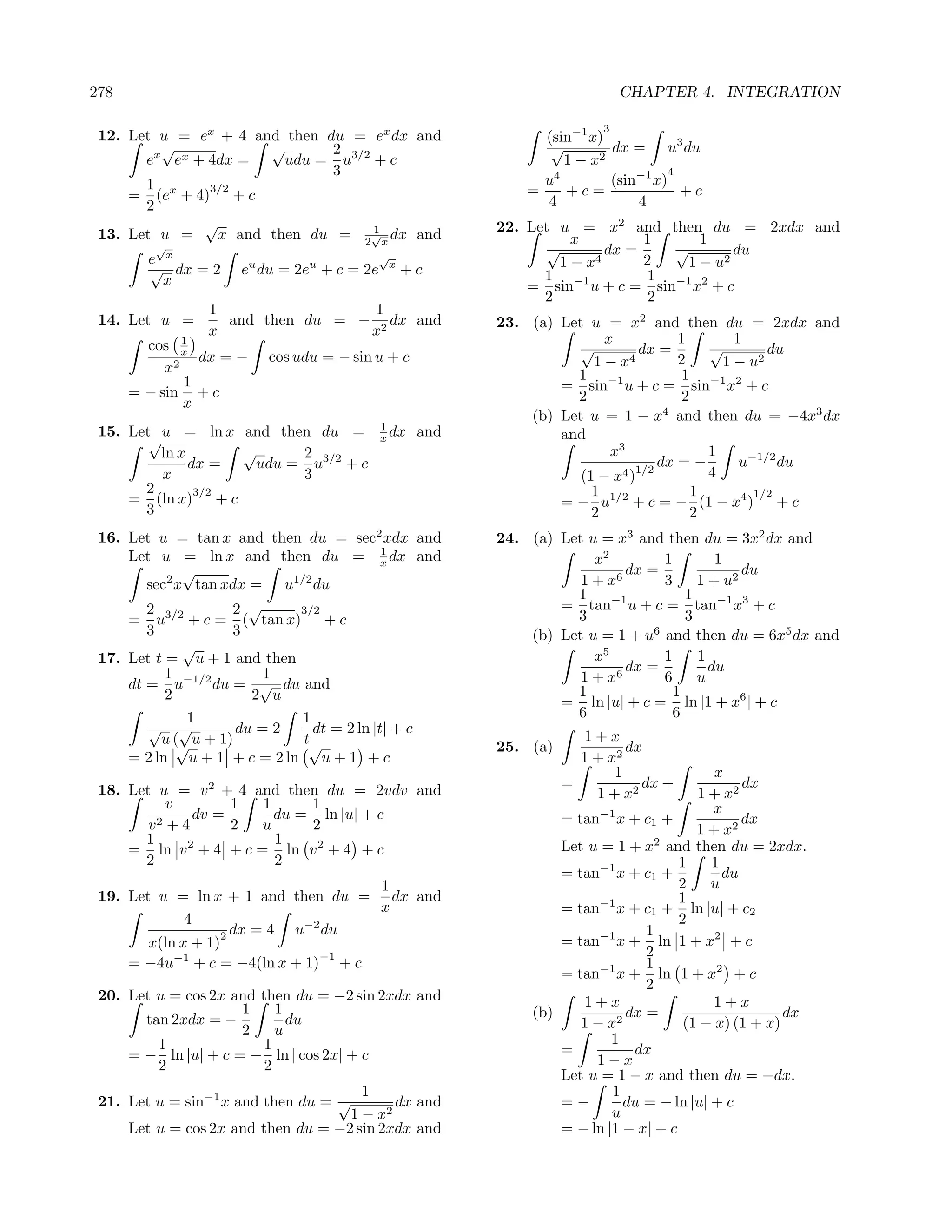
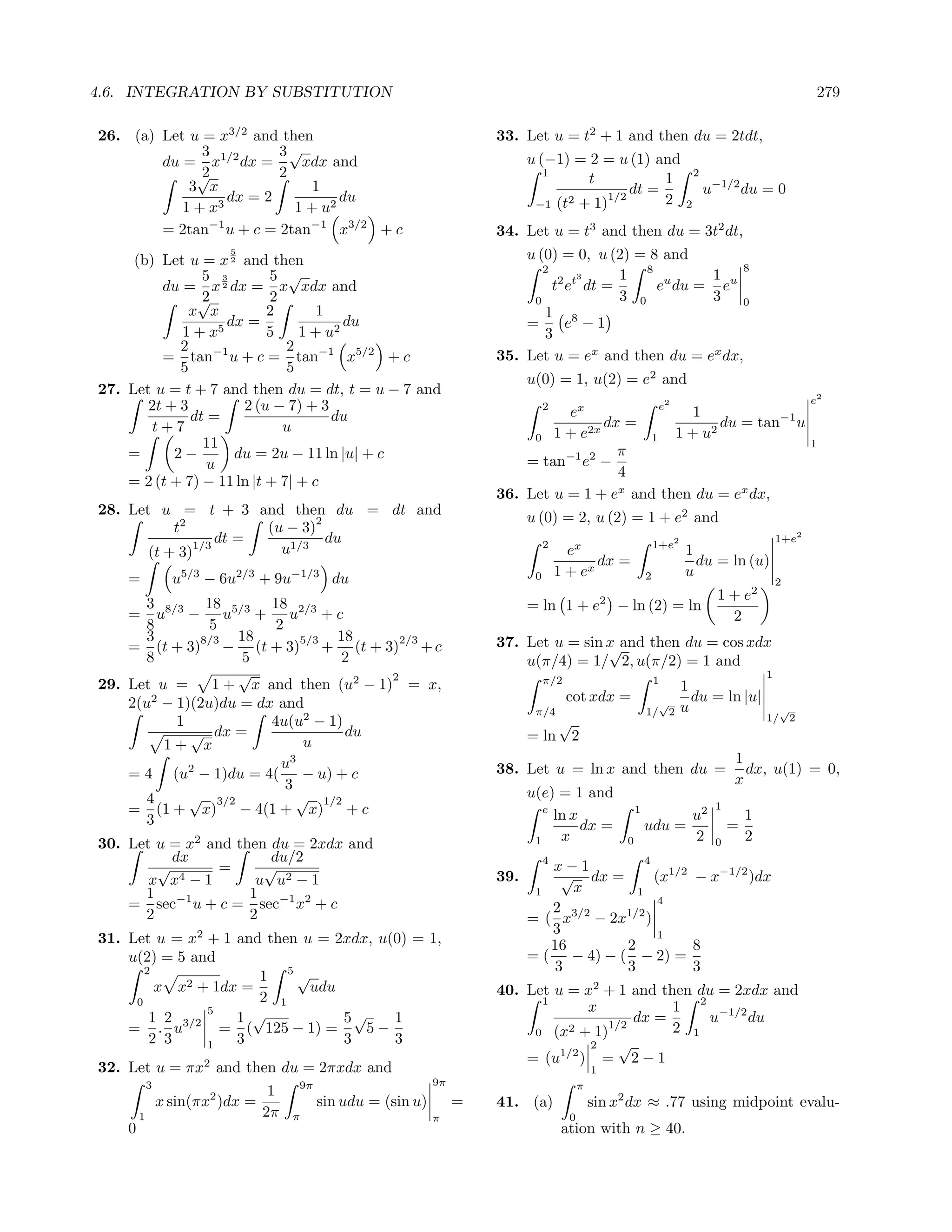
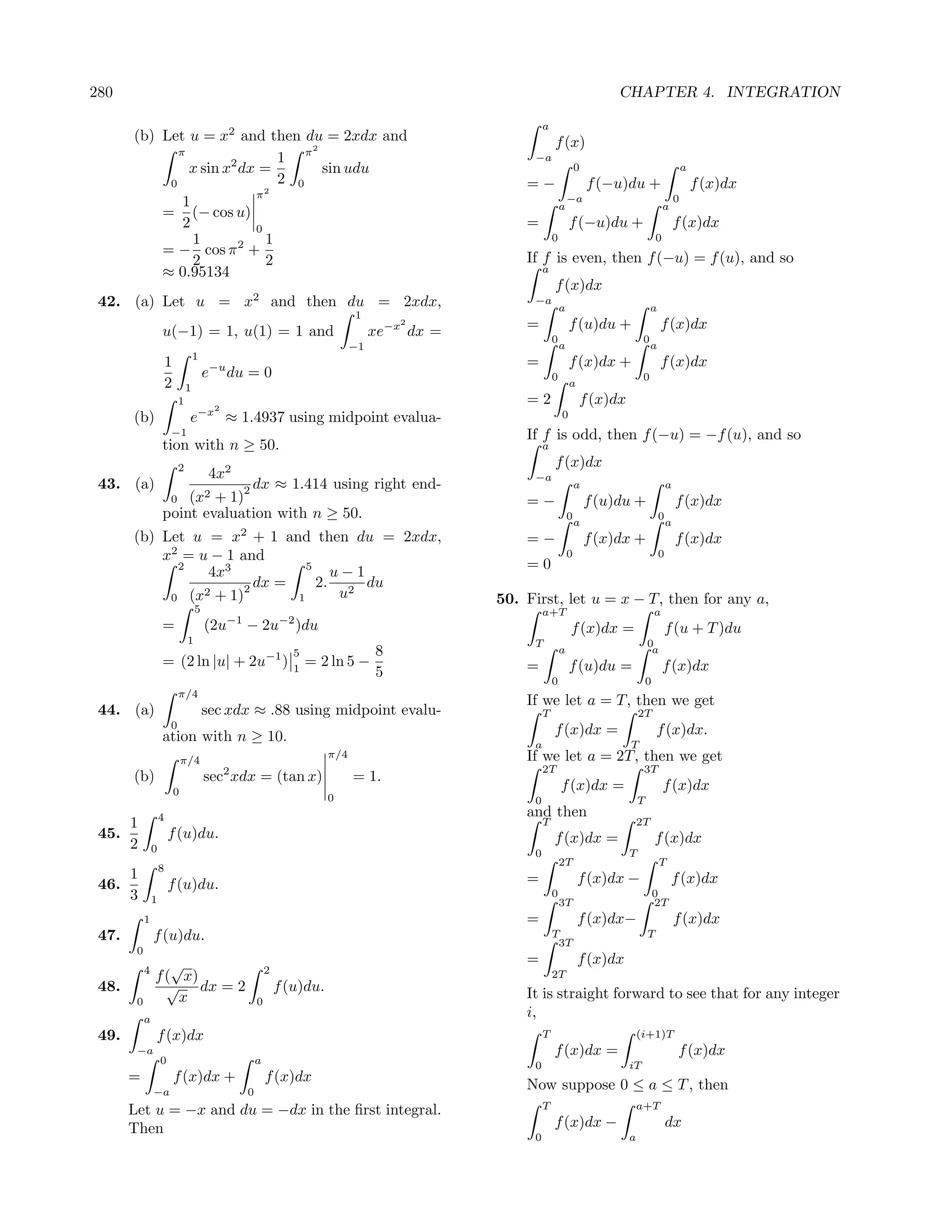
![4.6. INTEGRATION BY SUBSTITUTION 281
a a+T 0
f (a − u)
= f (x)dx − f (x)dx =− du
0 T a f (a − u) + f (u)
a
T a+T f (a − u)
= du
So f (x)dx = dx 0 f (a − u) + f (u)
a
0 a f (a − x)
I= dx
Now suppose a is any number. Then a must lie 0 f (a − x) + f (x)
in some interval [iT, (i + 1)T ] for some interger The last equation follows from the previ-
i. Use the similar method as in above, we shall ous one because u and x are dummy vari-
get ables of integration. Now note that
(i+1)T a+T
f (x)
f (x)dx = f (x)dx f (x) + f (a − x)
iT a f (x) + f (a − x) − f (a − x)
(i+1)T T =
And since f (x)dx = f (x)dx, f (x) + f (a − x)
iT 0 f (a − x)
T a+T =1−
we get f (x)dx = f (x)dx f (a − x) + f (x)
0 a Thus,
a
f (x)
dx
51. (a) Let u = 10 − x, so that du = −dx. Then, 0 f (x) + f (a − x)
10 √ a
x f (a − x)
I= √ √ dx = 1− dx
0 x + √ 10 − x 0 f (a − x) + f (x)
a a
x=10
10 − u f (a − x)
=− √ √ du = 1dx − dx
x=0 10 − u + u 0 0 f (a − x) + f (x)
u=0 √ 2I = a
10 − u
=− √ √ du I = a/2
u=10
u=10 √ −u+ u
10
10 − u
= √ √ du
u=0 10 − u + u
√ 52. (a) Let u = 6 − x, so that du = −dx.
x=10
10 − x Then,
I= √ √ dx 4
x=0 10 − x + x sin2 (9 − x)
I= dx
The last equation follows from the previ- 2 2
2 sin (9 − x) + sin (x + 3)
ous one because u and x are dummy vari- 2
sin2 (u + 3)
ables of integration. Now note that =− 2 2 du
√ 4 sin (u + 3) + sin (9 − u)
x 4
√ √ sin2 (u + 3)
x + 10 − x = du
√ √ √ 2 2
2 sin (u + 3) + sin (9 − u)
x + 10 − x − 10 − x 4
= √ √ sin2 (x + 3)
√ + 10 − x
x = 2 2 dx
2 sin (x + 3) + sin (9 − x)
10 − x 4
=1− √ √ sin2 (9 − x)
x + 10 − x = 1− dx
2 sin2 (x + 3) + sin2 (9 − x)
Thus, √ 4
10
x I= 1dx − I
√ √ dx 2
0 x + 10 √ x − 2I = 2
10
10 − x I=1
= 1− √ √ dx
0 x + 10 − x
√
10 10
10 − x (b) Let u = 6 − x, so that du = −dx.
= 1dx − √ √ dx
0 0 x + 10 − x Then,
4
10 f (9 − x)
I= 1dx − I I= dx
0 2 f (9 − x) + f (x + 3)
2
2I = 10 f (u + 3)
=− du
I=5 4 f (u + 3) + f (9 − u)
4
(b) Let u = a − x, so that f (u + 3)
= du
du = −dx Then, 2 f (u + 3) + f (9 − u)
a 4
f (x) f (x + 3)
I= dx = dx
0 f (x) + f (a − x) 2 f (x + 3) + f (9 − x)](https://image.slidesharecdn.com/ismetchapter4-111124021901-phpapp01/75/answers-tutor-8-42-2048.jpg)

![4.6. INTEGRATION BY SUBSTITUTION 283
1
x2 x3 58. The problem is that it is not true on entire in-
= π −
2 3 0 terval [0, π] that cos x = 1 − sin2 x. This is
π 1 only true on the interval 0, π . To make this
= − . 2
2 3 substitution correctly, one must break up the
The area of the region bounded by the curve integral:
π
y = π cos x − cos2 x sin x and x-axis, where
π/2
cos x(cos x)dx
π
0≤x≤ 2 is 0
π cos x − cos2 x sin xdx. 0
π/2 π
Let u = cos x and then du = − sin xdx. = cos x(cos x)dx + cos x(cos x)dx
π 0 π/2
u (0) = 1, u = 0. x=π/2
2
0 = 1 − u2 du
= −πu + u2 du x=0
x=π
1
0 − 1 − u2 du
u2 u3 x=π/2
= −π + x=π/2
2 3 1 u sin−1 u
π 1 = +
= − 2 2 x=0
2 3 x=π
u sin−1 u
Thus, the areas are equal. − +
2 2 x=π/2
−1 x=π/2
2.5 sin x sin (sin x)
= +
2 2 x=0
x=π
2.0
sin x sin−1 (sin x)
− +
1.5
2 2 x=π/2
1 π 1 π
= + −0−0+ +
1.0 2 4 2 4
π
=1+
0.5 2
0.0 59. Let u = 1/x, so that du = −1/x2 dx, which
0.0 0.25 0.5 0.75 1.0 means that −1/u2 du = dx. Then,
1 1
2.0
1 1/u2
1.8 2
dx = − 2
du
0 x +1 1/a 1/u + 1
1.6 1/a 1/a
1 1
1.4 = du = dx
1 1 + u2 1 1 + x2
1.2
1.0
The last equation follows from the previous one
0.8
because u and x are dummy variables of inte-
0.6
gration. Thus,
1 1/a
0.4
tan−1 x a = tan−1 x 1
1
0.2 tan−1 1 − tan−1 a = tan−1 − tan−1 1
a
0.0
1
tan−1 a + tan−1 = 2tan−1 1
57. The point is that if we let u = x4 , then we get a
1 π
x = ±u1/4 , and so we need to pay attention to tan−1 a + tan−1 =
a 2
the sign of u and x. A safe way is to solve the
original indefinite integral in terms of x, and 60. If u = 1/x, then du = −dx/x2 and
then solve the definite integral using boundary 1
√ dx
points in terms of x. |x| x2 − 1
1 x=1
1
4x4 dx = u1/4 du = √
2 x2 − 1
dx
−2 x=−2 x
4 5/4 4
x=1 x=1 1
= u = x5 =− √ du
5 5 x=−2 1 − u2
x=−2
4 5 4 132 = −sin−1 u + c
5
=
5
1 − (−2) = (1 − (−32)) =
5 5 = −sin−1 1/x + c](https://image.slidesharecdn.com/ismetchapter4-111124021901-phpapp01/75/answers-tutor-8-44-2048.jpg)
![284 CHAPTER 4. INTEGRATION
On the other hand,
1
√ dx = sec−1 x + c1 0.4
|x| x2 − 1
So −sin−1 1/x = sec−1 x + c2 . 0.3
Let x = 1, we get
sin−1 1 = sec−1 1 + c2
π 0.2
= 0 + c2
2
π 0.1
c2 =
2
0
0 0.5 1 1.5 2
x
2 √
x 4 − x2 dx
61. x = −2 63. V (t) = Vp sin(2πf t)V 2 (t)
2 √
4 − x2 dx
−2 = Vp2 sin2 (2πf t)
Examine the denominator of x, the graph of
√ 1 1
4 − x2 , which is indeed a semicircle, is sym- = Vp2 − cos (4πf t)
metric over the two intervals [−2, 0] and [0, 2], 2 2
while multiplying by x changes the symmetry Vp2
= (1 − cos (4πf t))
into anti-symmetry. In other words, 2
0 2 1/f
x 4 − x2 dx = − x 4 − x2 dx rms = f V 2 (t) dt
−2 0 0
so that 1/f
2 Vp2
x 4 − x2 dx = f (1 − cos (4πf t)) dt
−2 0 2
0 2 √ 1/f
= x 4 − x2 dx + x 4 − x2 dx = 0 Vp f sin (4πf t)
= √ t−
−2 0 2 4πf
Hence x = 0. √ 0
2 √ Vp f 1 Vp
Now the integral −2 4 − x2 dx is the area of = √ =√
2 f 2
a semicircle with radius 2, thus its value is
(1/2) π22 = 2π. Then
2 √ 2 2
−2
4 − x2 dx 64. f 2 (t)dt
y= 2 √ −2
2 −2 4 − x2 dx −1 1 2
2
4−x 2
dx = 1dt + t2 dt + 1dt
−2 −2 −1 1
= 2 8
2.2π =1+ +1=
0 2
−2
4 − x2 dx + 0
4−x 2
dx 3 3
=
4π 1 2 2
2 rms = f (t) dt
2 4 − x2 dx
0 4 1
=
4π 1 8 2
2
4 − x2 dx = =
= 0 4 3 3
2π
2
1 x3 8
= 4x − =
2π 3 0 3π 1
0.5
62. These animals are likely to be found 0.7 miles 0
from the pond. Let u = −x2 , then du = -2 -1 0 1
t
2
−2xdx, u(0) = 0, u(2) = −4 and
-0.5
2
2 1 −4 u
xe−x dx = − e du
0 2 0
1 − e−4
-1
1
= − e−4 − 1 =
2 2](https://image.slidesharecdn.com/ismetchapter4-111124021901-phpapp01/75/answers-tutor-8-45-2048.jpg)
![4.7. NUMERICAL INTEGRATION 285
4.7 Numerical Integration 1
= (1 + 5 + 4 + 13 + 5)
6
14
1. Midpoint Rule: =
1
3
x2 + 1 dx
0
3. Midpoint Rule:
1 1 3 5 7 31
≈ f +f +f +f dx
4 8 8 8 8
85 1 x
= 3−1 5 7 9 11
64 ≈ f +f +f +f
4 4 4 4 4
Trapezoidal Rule:
1 4 4 4 4
1 = + + +
x2 + 1 dx 2 5 7 9 11
0
3776
=
1−0 1 1 3 3465
≈ f (0) + 2f + 2f + 2f
2 (4) 4 2 4 Trapezoidal Rule:
+f (1)] 3
43 1
= dx
32 1 x
Simpson’s Rule: 3−1 3 5
≈ f (1) + 2f + 2f (2) + 2f
1 2 (4) 2 2
x2 + 1 dx +f (3)]
0 1 4 4 1
1−0 1 1 3 = 1+ +1+ +
= f (0) + 4f + 2f + 4f 4 3 5 3
3 (4) 4 2 4 67
+f (1)] =
60
4
= Simpson’s Rule:
3
31
2. Midpoint Rule: dx
1 x
2
x2 + 1 dx 3−1 3 5
= f (1) + 4f + 2f (2) + 4f
0 3 (4) 2 2
1 1 3 5 7 +f (3)]
≈ f +f +f +f
2 4 4 4 4 1 8 8 1
1 17 25 41 65 = 1+ +1+ +
= + + + 6 3 5 3
2 16 16 16 16 11
37 =
= 10
8
Trapezoidal Rule:
4. Midpoint Rule:
2
x2 + 1 dx 1
0 2x − x2 dx
1 1 3 −1
≈ f (0) + 2f + 2f (1) + 2f 1 3 1 1 3
4 2 2 ≈ f − +f − +f +f
+f (2)] 2 4 4 4 4
1 5 13 1 33 9 7 15
= 1+ +4+ +5 = − − + +
4 2 2 2 16 16 16 16
19 −5
= =
4 8
Simpson’s Rule: Trapezoidal Rule:
2 1
x2 + 1 dx 2x − x2 dx
0 −1
1 1 3 1 1 1
= f (0) + 4f + 2f (1) + 4f ≈ f (−1) + 2f − + 2f (0) + 2f
6 2 2 4 2 2
+f (2)] +f (1)]](https://image.slidesharecdn.com/ismetchapter4-111124021901-phpapp01/75/answers-tutor-8-46-2048.jpg)
![286 CHAPTER 4. INTEGRATION
1 5 3 8. Midpoint Rule: e2 − 7.322986 = 7.389056 −
= −3 − +0+ +1
4 2 2 7.322986
3 = 0.06607
=−
4 Trapezoidal Rule: e2 − 7.52161 = 7.389056 −
Simpson’s Rule: 7.52161
1 = −0.132554
2x − x2 dx Simpson’s Rule: e2 − 7.391210 = 7.389056 −
−1
7.391210
1 1 1
≈ f (−1) + 4f − + 2f (0) + 4f = −0.002154
6 2 2 Hence, the approximation using Simpson’s
+f (1)]
1 Rule is too small and the Approximation us-
= (−3 − 5 + 0 + 3 + 1) ing Trapezoidal Rule is too large.
6
2 π
=− 9. cos x2 dx
3
0
5. Midpoint Rule: n M idpoint T rapezoidal Simpson
ln 4 − 1.366162 = 1.386294 − 1.366162 10 0.5538 0.5889 0.5660
= 0.020132 20 0.5629 0.5713 0.5655
50 0.5652 0.566 0.5657
Trapezoidal Rule:
π
ln 4 − 1.428091 = 1.386294 − 1.428091 4
= −0.041797 10. sin πx2 dx
0
Simpson’s Rule: n M idpoint T rapezoidal Simpson
10 0.386939 0.385578 0.386476
ln 4 − 1.391621 = 1.386294 − 1.391621
20 0.386600 0.386259 0.386485
= −0.005327
50 0.386504 0.386450 0.386486
Hence, the approximation using Simpson’s
Rule is too small and the Approximation us- 2 2
ing Trapezoidal Rule is too large. 11. e−x dx
0
n M idpoint T rapezoidal Simpson
6. Midpoint Rule:
ln 8 − 1.987287 = 2.079442 − 1.987287 10 0.88220 0.88184 0.88207
= 0.092155 20 0.88211 0.88202 0.88208
Trapezoidal Rule: 50 0.88209 0.88207 0.88208
ln 8 − 2.289628 = 2.079442 − 2.289628 3 2
= −0.210186 12. e−x dx
Simpson’s Rule: 0
ln 8 − 2.137327 = 2.079442 − 2.137327 n M idpoint T rapezoidal Simpson
= −0.057885 10 0.886210 0.886202 0.886207
Hence, the approximation using Simpson’s 20 0.886208 0.886206 0.886207
Rule is too small and the Approximation us- 50 0.886207 0.886207 0.886207
ing Trapezoidal Rule is too large. π
13. ecos x dx
7. Midpoint Rule: 0
sin 1 − 0.843666 = 0.841471 − 0.843666 n M idpoint T rapezoidal Simpson
= −0.002195 10 3.9775 3.9775 3.9775
Trapezoidal Rule: sin 1 − 0.837084 = 20 3.9775 3.9775 3.9775
0.841471 − 0.837084 50 3.9775 3.9775 3.9775
= 0.004387
Simpson’s Rule:
1 √
3
14. x2 + 1dx
sin 1 − 0.841489 = 0.841471 − 0.841489 0
= −0.000018 n M idpoint T rapezoidal Simpson
Hence, the approximation using Simpson’s 10 3.333017 3.336997 3.334337
Rule is too small and the Approximation us- 20 3.334012 3.335007 3.334344
ing Trapezoidal Rule is too large. 50 3.334291 3.334450 3.334344](https://image.slidesharecdn.com/ismetchapter4-111124021901-phpapp01/75/answers-tutor-8-47-2048.jpg)
![4.7. NUMERICAL INTEGRATION 287
15. The exact value of this integral is n Simpson ESn
1 10 0 0
1
5x4 dx = x5 0 =1−0=1 20 0 0
0
n M idpoint EMn 40 0 0
10 1.00832 8.3 × 10−3 80 0 0
20 1.00208 2.1 × 10−3
18. The exact value of this integral is
40 1.00052 5.2 × 10−3 π
4
80 1.00013 1.3 × 10−3 1
cos xdx = √
n T rapezoidal ETn 2
0
10 0.98335 1.6 × 10−2 n M idpoint EMn
20 0.99583 4.1 × 10−3 10 0.707289 1.8 × 10−4
40 0.99869 1.0 × 10−3 20 0.707152 4.5 × 10−5
80 0.99974 2.6 × 10−4 40 0.707118 1.1 × 10−5
n Simpson ESn 80 0.707110 2.8 × 10−6
10 1.000066 6.6 × 10−5 n T rapezoidal ETn
20 1.0000041 4.2 × 10−6 10 0.706743 3.6 × 10−4
40 1.00000026 2.6 × 10−7 20 0.707016 9.1 × 10−5
80 1.00000016 1.6 × 10−8 40 0.707084 2.3 × 10−5
80 0.707101 5.7 × 10−6
16. The exact value of this integral is
2 1 n Simpson ESn
dx = ln 2 10 0.7071087 1.5 × 10−7
1 x
n M idpoint EMn 20 0.7071068 9.5 × 10−9
10 0.692835 3.1 × 10−4 40 0.7071068 6 × 10−10
20 0.693069 7.8 × 10−5 80 0.7071068 6 × 10−10
40 0.693128 2.0 × 10−5 19. If you double the error in the Midpoint Rule is
80 0.693142 4.9 × 10−6 divided by 4, the error in the Trapezoidal Rule
n T rapezoidal ETn is divided by 4 and the error in the Simpson’s
10 0.693771 6.2 × 10−4 Rule is divided by 16.
20 0.693303 1.6 × 10−4
40 0.693186 3.9 × 10−5 20. If you halve the interval length b − a the error
80 0.693157 9.8 × 10−6 in the Midpoint Rule is divided by 8, the error
in the Trapezoidal Rule is divided by 8 and the
n Simpson ESn error in the Simpson’s Rule is divided by 32.
10 0.693150 3.1 × 10−6
20 0.693147 1.9 × 10−7 21. Trapezoidal Rule:
40 0.693147 1.2 × 10−8 2
80 0.693147 8.0 × 10−10 f (x) dx
0
2−0
17. The exact value of this integral is ≈ [f (0) + 2f (0.25) + 2f (0.5)
2 (8)
π
π + 2f (0.75) + 2f (1) + 2f (1.25) + 2f (1.5)
cos xdx = sin x|0 = 0
0
+ 2f (1.75) + f (2)]
n M idpoint EMn 1
= [4.0 + 9.2 + 10.4 + 9.6 + 10 + 9.2 + 8.8
10 0 0 8
+ 7.6 + 4.0]
20 0 0
= 9.1
40 0 0
Simpson’s Rule:
80 0 0 2
f (x) dx
n T rapezoidal ETn 0
10 0 0 2−0
≈ [f (0) + 4f (0.25) + 2f (0.5)
20 0 0 3 (8)
40 0 0 + 4f (0.75) + 2f (1) + 4f (1.25) + 2f (1.5)
80 0 0 +4f (1.75) + f (2)]](https://image.slidesharecdn.com/ismetchapter4-111124021901-phpapp01/75/answers-tutor-8-48-2048.jpg)
![288 CHAPTER 4. INTEGRATION
1 1
= [4.0 + 18.4 + 10.4 + 19.2 + 10.0 |ET4 | ≤ 1 ≈ 0.005
12 12 · 42
+18.4 + 8.8 + 15.2 + 4.0] 1
|EM4 | ≤ 1 ≈ 0.003
≈ 9.033 24 · 42
1
|ES4 | ≤ 1 ≈ 2.17 × 10−5
22. Trapezoidal Rule: 180 · 44
2
(b − a)3 1
f (x) dx (b) Midpoint: |En |K =
0 24n2 24n2
0.25
≈ [f (0) + 2f (0.25) + 2f (0.5) 1
2 We want ≤ 107
+2f (0.75) + 2f (1) + 2f (1.25) + 2f (1.5) 24n2
+2f (1.75) + f (2)] 24n2 ≥ 107
0.25
= [(1.0) + 2(0.6) + 2(0.2) + 2(−0.2) 107
2 n2 ≥
+ 2(−0.4) + 2(0.4) + 2(0.8) 24
+ 2(1.2) + (2.0)]
107
= 1.025. n≥ ≈ 645.5
Simpson’s Rule: 24
2 So need n ≥ 646.
f (x) dx (b − a)3 1
0 Trapezoid: |ETn |K 2
=
0.25 12n 12n2
≈ [f (0) + 4f (0.25) + 2f (0.5)
3 107
+ 4f (0.75) + 2f (1) + 4f (1.25) + 2f (1.5) We want n2 ≥
12
+4f (1.75) + f (2)] 107
0.25 n≥ ≈ 912.87
= [(1.0) + 4 (0.6) + 2 (0.2) + 4 (−0.2) 12
3
+2 (−0.4) + 4 (0.4) + 2 (0.8) + 4 (1.2) + (2.0)] n ≥ 913
≈ 1.016667 (b − a)5 1
Simpson: |ESn |L 4
=
1 2 24 180n 180n4
23. (a) f (x) = , f (x) = 3 , f (4) (x) = 5 . 1
x x x ≤ 10−7
Then K = 2, L = 24. Hence according to 180n4
Theorems 9.1 and 9.2, 180n4 ≥ 107
3
(4 − 1) 107
|ET4 | ≤ 2 ≈ 0.281 n4 ≥
12 · 42 180
3
(4 − 1)
|EM4 | ≤ 2 ≈ 0.141 107
4
24 · 42 n≥ ≈ 15.4
(4 − 1)
5 180
|ES4 | ≤ 24 ≈ 0.127 So need n ≥ 16.
180 · 42
(b) Using Theorems 9.1 and 9.2, and the cal- 25. (a) f (x) = ln x. Hence, f (x) = x and 1
culation in Example 9.10, we find the 1
f (x) = − x2 . Therefore |f (x)| ≤ 1.
following lower bounds for the number The error using Trapezoidal Rule is
of steps needed to guarantee accuracy of (2 − 1)
3
10−7 in Exercise 5: |E (Tn )| ≤ 1 ≤ 10−6
12n2
2 · 33 1
Midpoint: ≈ 4745 |E (Tn )| ≤ ≤ 10−6
24 · 10−7 12n2
Solving for n,
2 · 33 1 6
Trapezoidal: ≈ 6709 |E (Tn )| ≤ 10 ≤ n2
14 · 10−7 12
1 6
4 24 · 35 n≥ 10
Simpson’s: ≈ 135 12
180 · 10−7 ≈ 288.67
24. (a) f (x) = cos x, f (x) = − cos x,
1
f (4) (x) = cos x.Then K = L = 1. (b) f (x) = ln x. Hence, f (x) = x , f (x) =
1
Hence according to − x2 . Therefore |f (x)| ≤ 1.
Theorems 9.1 and 9.2, The error using Midpoint Rule is](https://image.slidesharecdn.com/ismetchapter4-111124021901-phpapp01/75/answers-tutor-8-49-2048.jpg)
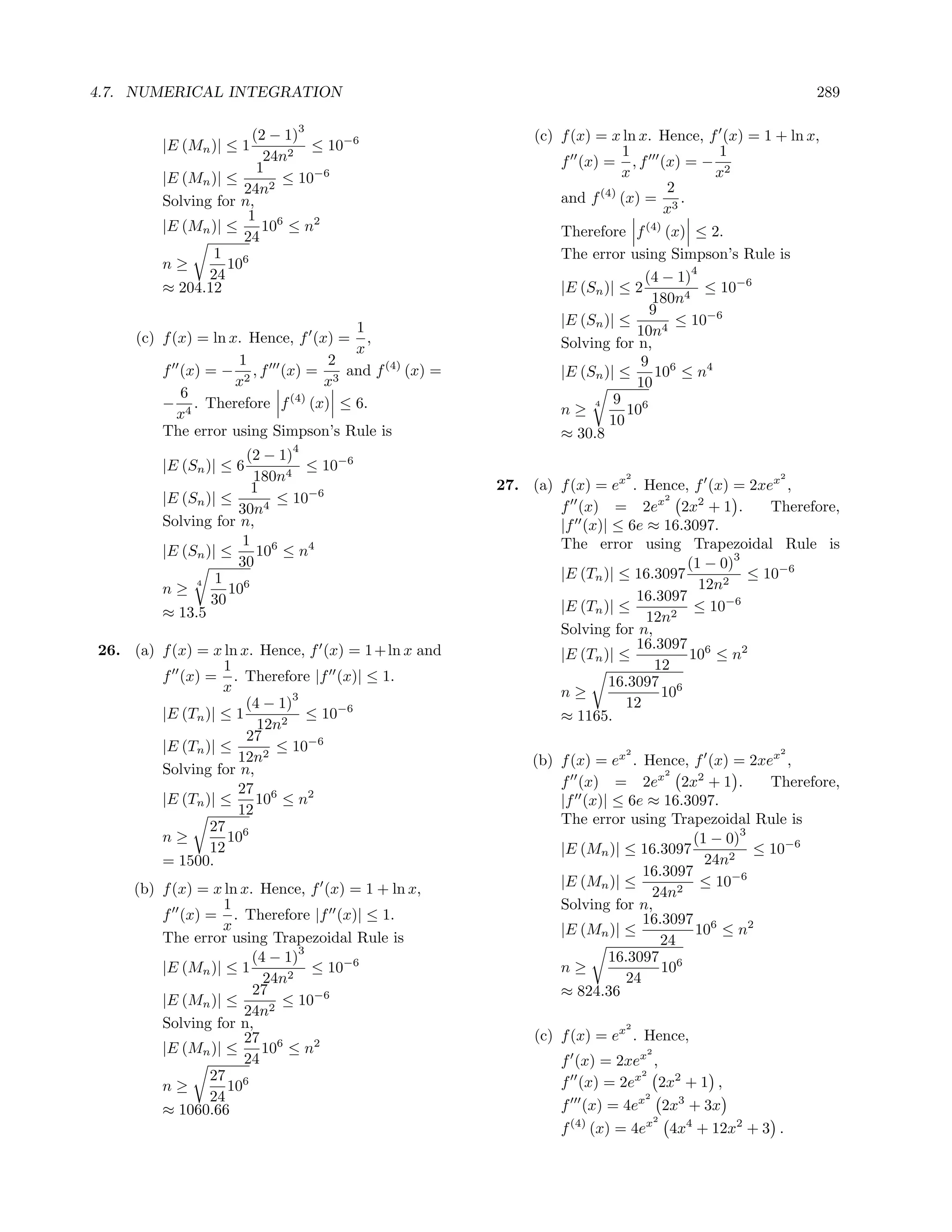
![290 CHAPTER 4. INTEGRATION
Therefore, |f (x)| ≤ 76e ≈ 206.5823. f (4) (x) ≤ 6e2 ≈ 31.82
The error using Simpson’s Rule is The error using Simpson’s Rule is
4
(1 − 0) (2 − 1)
4
|E (Sn )| ≤ 206.5823 ≤ 10−6 |E (Sn )| ≤ 31.82 ≤ 10−6
180n4 180n4
206.5823 31.82
|E (Sn )| ≤ ≤ 10−6 |E (Sn )| ≤ ≤ 10−6
180n2 180n2
Solving for n, Solving for n,
206.5823 6 31.82 6
|E (Sn )| ≤ 10 ≤ n2 |E (Sn )| ≤ 10 ≤ n2
180 180
4 206.5823
n≥ 106 4 31.82
180 n≥ 106
180
≈ 32.7307. ≈ 20.50486515
28. (a) f (x) = xex
Hence, 29. We use K = 60, L = 120
f (x) = ex (x + 1)
n EMn Error Bound
f (x) = ex (x + 2)
10 8.3 × 10−3 2.5 × 10−2
Therefore,
|f (x)| ≤ 4e2 ≈ 21.21 n ETn Error Bound
The error using Midpoint Rule is 10 1.6 × 10−2 5 × 10−2
3
(2 − 1) n ESn Error Bound
|E (Mn )| ≤ 21.21 ≤ 10−6
24n2 10 7.0 × 10−5 6.6 × 10−3
21.21
|E (Mn )| ≤ ≤ 10−6
24n2 30. We use K = L = 1.
Solving for n, n EMn Error Bound
2402.0293 6
|E (Mn )| ≤ 10 ≤ n2 10 0 1.3 × 10−2
24
21.21 6 n ETn Error Bound
n≥ 10
24 10 0 2.6 × 10−2
≈ 940.0797838
n ESn Error Bound
10 0 1.7 × 10−4
(b) f (x) = xex
Hence, 31. (a) Left Endpoints:
f (x) = ex (x + 1) 2
f (x) = ex (x + 2) f (x)dx
0
Therefore, 2−0
≈ [f (0) + f (.5) + f (1)
|f (x)| ≤ 4e2 ≈ 21.21 4
The error using Trapezoidal Rule is +f (1.5)]
3
(2 − 1)
|E (Tn )| ≤ 21.21 ≤ 10−6 1
= (1 + .25 + 0 + .25)
12n2 2
21.21
|E (Tn )| ≤ ≤ 10−6 = .75
12n2
Solving for n, (b) Midpoint Rule:
21.21 6 2
|E (Tn )| ≤ 10 ≤ n2
12 f (x)dx
21.21 6 0
n≥ 10 2−0
12 ≈ [f (.25) + f (.75)
≈ 1329.473580 4
+f (1.25) + f (1.75)]
(c) f (x) = xex 1
= (.65 + .15 + .15 + .65)
Hence, 2
f (x) = ex (x + 1) , f (x) = ex (x + 2) = .7
f (x) = ex (x + 3) (c) Trapezoidal Rule:
f (4) (x) = ex (x + 4) 2
Therefore, f (x)dx
0](https://image.slidesharecdn.com/ismetchapter4-111124021901-phpapp01/75/answers-tutor-8-51-2048.jpg)
![4.7. NUMERICAL INTEGRATION 291
2−0 (b) Trapezoidal Rule:
≈ [f (0) + 2f (.5) + 2f (1)
2(4) b
Tn > f (x)dx
+2f (1.5) + f (2)] a
1
= (1 + .5 + 0 + .5 + 1) (c) Simpson’s Rule:
4 Not enough information.
= .75
2 34. (a) Midpoint Rule:
b
(d) Simpson’s rule: f (x) dx
Mn < f (x)dx
0 a
2
= [f (0) + 4f (0.5) + 2f (1) (b) Trapezoidal Rule:
12
+4f (1.5) + f (2)] b
1 Tn > f (x)dx
= [1 + 4(0.25) + 2(0) + 4(0.25) + 1] a
6
1 (c) Simpson’s Rule:
= [4]
6 b
= 0.66666 Sn ≥ f (x)dx
a
32. (a) Left Endpoints:
2
f (x)dx 35. (a) Midpoint Rule:
b
0
1 Mn > f (x)dx
≈ (f (0) + f (.5) + f (1) + f (1.5)) a
2
1 (b) Trapezoidal Rule:
= (0.5 + 0.8 + 0.5 + 0.1) b
2
Tn < f (x)dx
= 0.95 a
(b) Midpoint Rule:
2 (c) Simpson’s Rule:
f (x) dx Not enough information.
0
1 b
≈ (0.7 + 0.8 + 0.4 + 0.2) 36. (a) Midpoint Rule: Mn > f (x)dx
2 a
= 1.05
b
(c) Trapezoidal Rule: (b) Trapezoidal Rule: Tn < f (x)dx
2 a
f (x)dx b
0
1 (c) Simpson’s Rule: Sn ≤ f (x)dx
≈ [0.5 + 2(0.8) + 2(0.5) + 2(0.1) a
4
b
+ 0.5]
37. (a) Midpoint Rule: Mn < f (x)dx
= 0.95 a
2
b
(d) Simpson’s rule: f (x) dx (b) Trapezoidal Rule: Tn > f (x)dx
a
0
2−0 b
= [f (0) + 4f (0.5) + 2f (1) (c) Simpson’s Rule: Sn = f (x)dx
12
+4f (1.5) + f (2)] a
1
= [0.5 + 4(0.9) + 2(0.5) + 4(0.1) + 0.5] b
6 38. (a) Midpoint Rule: Mn = f (x)dx
1 a
= [0.5 + 3.6 + 1 + 0.4 + 0.5]
6 b
=1
(b) Trapezoidal Rule: Tn = f (x)dx
a
33. (a) Midpoint Rule:
b b
Mn < f (x)dx (c) Simpson’s Rule: Sn = f (x)dx
a a](https://image.slidesharecdn.com/ismetchapter4-111124021901-phpapp01/75/answers-tutor-8-52-2048.jpg)
![292 CHAPTER 4. INTEGRATION
39. 1 1 1
2 (RL + RR ) −√ + √ =0
n−1 n 3 3
= f (xi ) + f (xi )
i=0 i=1 1
n−1 n−1 2
= f (x0 ) + f (xi ) + f (xi ) + f (xn ) (b) x2 dx =
3
i=1 i=1 −1
n−1 2 3
= f (x0 ) + 2 f (xi ) + f (xn ) = Tn 1 1 2
i=1
−√ + √ =
3 3 3
1
40.
y (c) x3 dx = 0
2 −1
3 3
1 1
−√ + √ =0
3 3
1 44. Simpson’s Rule with n = 2 :
1
πx
π cos dx
2
−1
0 x 2 −1
0.5 1 ≈ f (−1) + 4f + f (1)
6 3
1√ 1 −π −π π
41. I1 = 1 − x2 dx is one fourth of the area of = π cos + 4π cos + π cos
0
3 2 6 2
1 π √ 2π
π = 0+2 3+0 = √
a circle with radius 1, so 1 − x2 dx = 3 3
4 ≈ 3.6276
0
1
1 1 Gaussian quadrature:
I2 = dx = arctan x|0 1
1 + x2 πx
0 π cos dx
π 2
= arctan 1 − arctan 0 = −1
√ 4
1
n Sn ( 1 − x2 ) Sn ( 1+x2 ) −1 1
≈f √ +f √
4 0.65652 0.78539 3 3
π π
8 0.66307 0.78539 = π cos − √ + π cos √
2 3 2 3
1 ≈ 3.87164
The second integral dx provides a
1 + x2
better algorithm for estimating π.
sin x
h 45. Simpson’s Rule is not applicable because
x
42. Ax2 + Bx + c dx sin x
is not defined at x = 0. L = lim
x→0 x
−h cos x
h = lim = cos 0 = 1
A 3 B 2 x→0 1
= x + x + cx sin x
3 2 −h The two functions f (x) and differ only
2 3 x
π π sin x
= Ah + 2Ch
3 at one point,so f (x) dx = dx We can
h 0 0 x
= 2Ah2 + 6C now apply Simpson’s Rule with n = 2 :
3 π
h f (x) dx
= [f (−h) + 4f (0) + f (h)]
3 0
π 4 sin π sin π
1 ≈ 1+ π +
6 2 π
43. (a) xdx = 0 π 1 8
= +
−1 2 3 3π](https://image.slidesharecdn.com/ismetchapter4-111124021901-phpapp01/75/answers-tutor-8-53-2048.jpg)
![4.7. NUMERICAL INTEGRATION 293
π
≈ · 1.18 49. f (x) + f (1 − x)
2 2
x2 (1 − x)
= 2 +
2x − 2x + 1 2(1 − x)2 − 2(1 − x) + 1
sin x
46. The function is not defined at x = 0, and x2
x = 2
it is symmetric across the y-axis. We define a 2x − 2x + 1
2
new function (1 − x)
+
sin x/x if x = 0 2 (1 − 2x + x2 ) − 2 + 2x + 1
f (x) = x2 (1 − x)
2
1 if x = 0 = 2 + 2
π/2
sin x 2x − 2x + 1 2x − 2x + 1
over the interval [0, π/2], and dx = 2
x2 (1 − x)
−π/2 x = +
2 2
π/2 x2 + (x − 1) (1 − x) + x2
2 f (x)dx 2 2
x + (1 − x)
0 = 2
Use Simpson’s Rule on n = 2: x2 + (1 − x)
π/2 =1
f (x)dx By Trapezoidal Rule,
0 √ 1
2
π 1
≈ 1+ 2 + f (x) dx
12 π/4 π/2
0
π
≈ · 15.22 (1 − 0)
2 = [f (x0 ) + 2f (x1 )
Hence 2n
+ 2f (x2 ) + ... + 2f (xn−1 ) + f (xn )]
π/2
sin x π (1 − 0) 1
dx ≈ · 30.44 = f (0) + 2f ( )
−π/2 x 2 2n n
2 n−1
+ 2f ( ) + ... + 2f ( ) + f (1)
47. Let I be the exact integral. Then we have n n
as f (x) + f (1 − x) = 1,
Tn − I ≈ −2(Mn − I)
we have,
Tn − I ≈ 2I − 2Mn
f (0) + f (1) = 1,
Tn + 2Mn ≈ 3I 1 n−1
Tn 2 f( ) + f( )=1
+ Mn ≈ I n n
3 3 2 n−2
f( ) + f( )=1
48. The text does not say this, but we want to n n
.
show that .
1
+ 2 Mn = S2n .
3 Tn 3 n−1 1
In this case, we have data points: f( ) + f( ) = 1
n n
x0 , x1 , x2 , x3 , ..., x2n . Adding the above n equations, we get
The midpoint rule will use the points: 1 n−1
x1 , x3 , ..., x2n−1 . f (0) + 2f ( ) + .. + 2f ( ) + f (1) = n
n n
The trapezoidal rule will use the points: Hence,
x0 x2 , ..., x2n . 1
1 2 1 1
Tn + Mn f (x) dx = (n) =
3 3 2n 2
1 b−a 0
= [f (x0 ) + 2f (x2 ) + 2f (x4 )
3 2n n
+ ... + 2f (x2n−2 ) + f (x2n )]
2 b−a 50. xn dx
+ × [f (x1 ) + f (x3 ) 0
3 n
+ f (x5 ) + ... + f (x2n−1 ) + f (x2n )] n−0
= [f0 + 2f1 + 2f2 + ... + 2fn−1 + fn ]
b−a 2n
= [f (x0 ) + 4f (x1 ) + 2f (x2 ) 1
2n = [f (0) + 2f (1) + 2f (2) + 2f (3) + .........
+ 4f (x3 ) + 2f (x4 ) + ... + 2f (x2n−2 ) 2
+ 2f (n − 1) + f (n)]
+ 4f (x2n−1 ) + f (x2n )] 1 n
= S2n = [(nn ) + 2(1n + 2n + 3n + ....... + (n − 1) ]
2](https://image.slidesharecdn.com/ismetchapter4-111124021901-phpapp01/75/answers-tutor-8-54-2048.jpg)
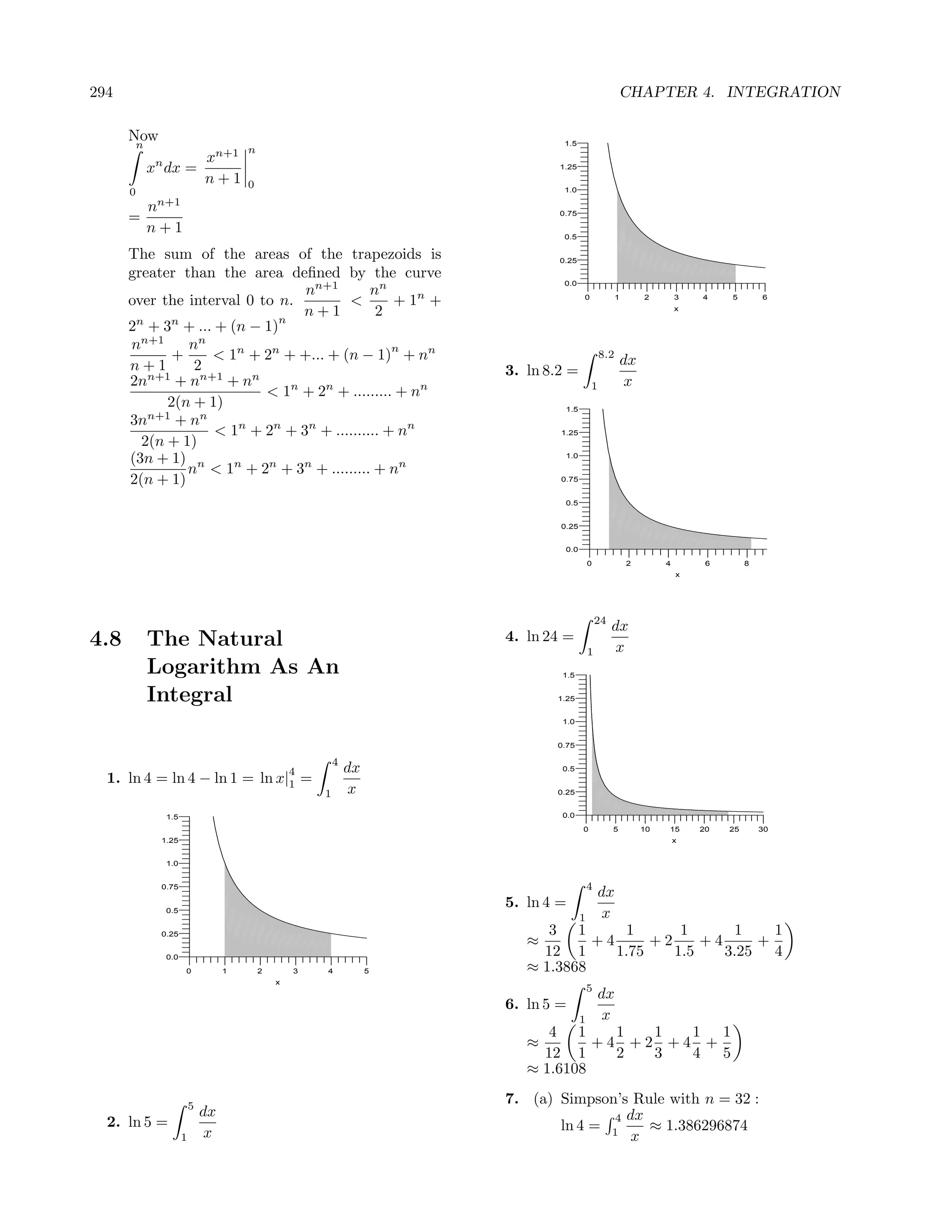
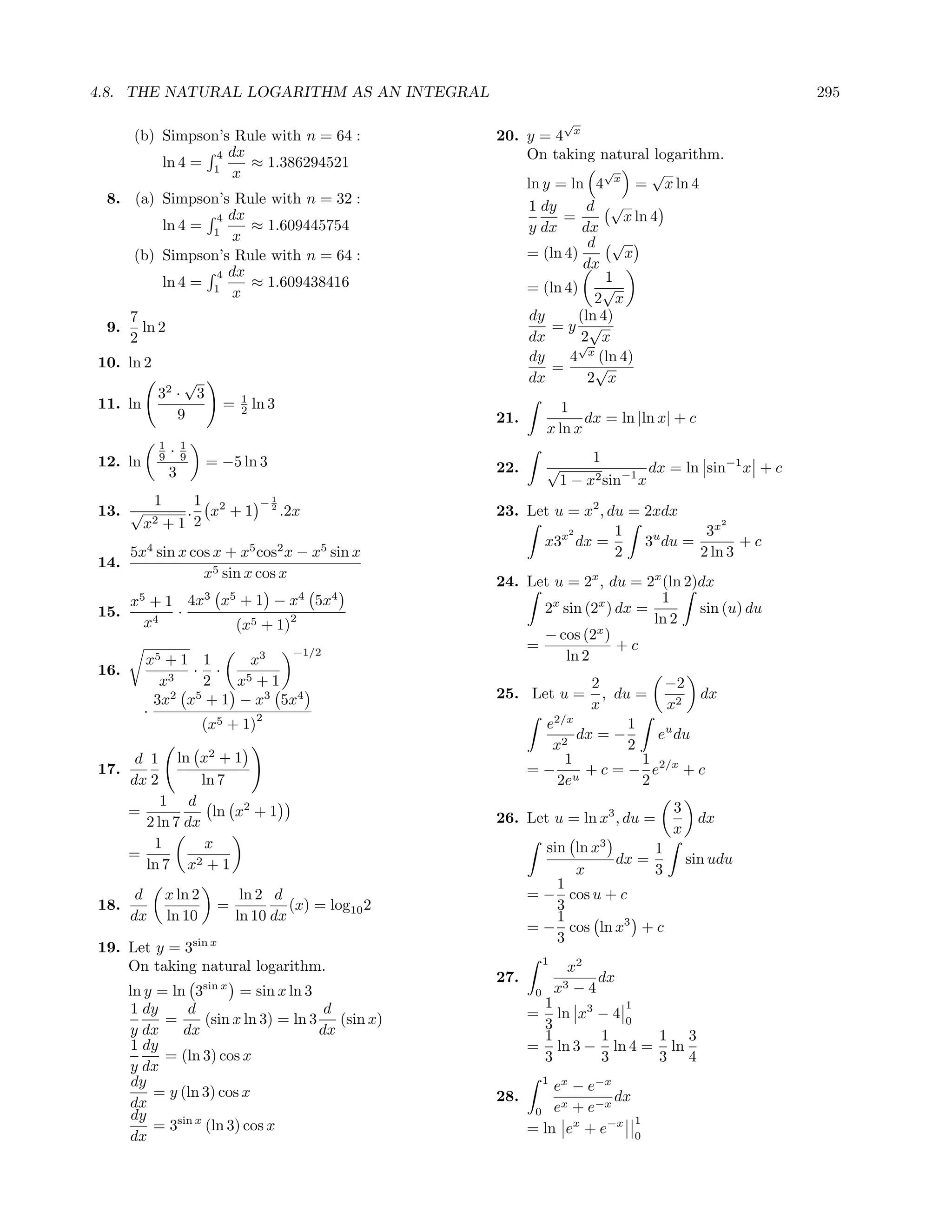
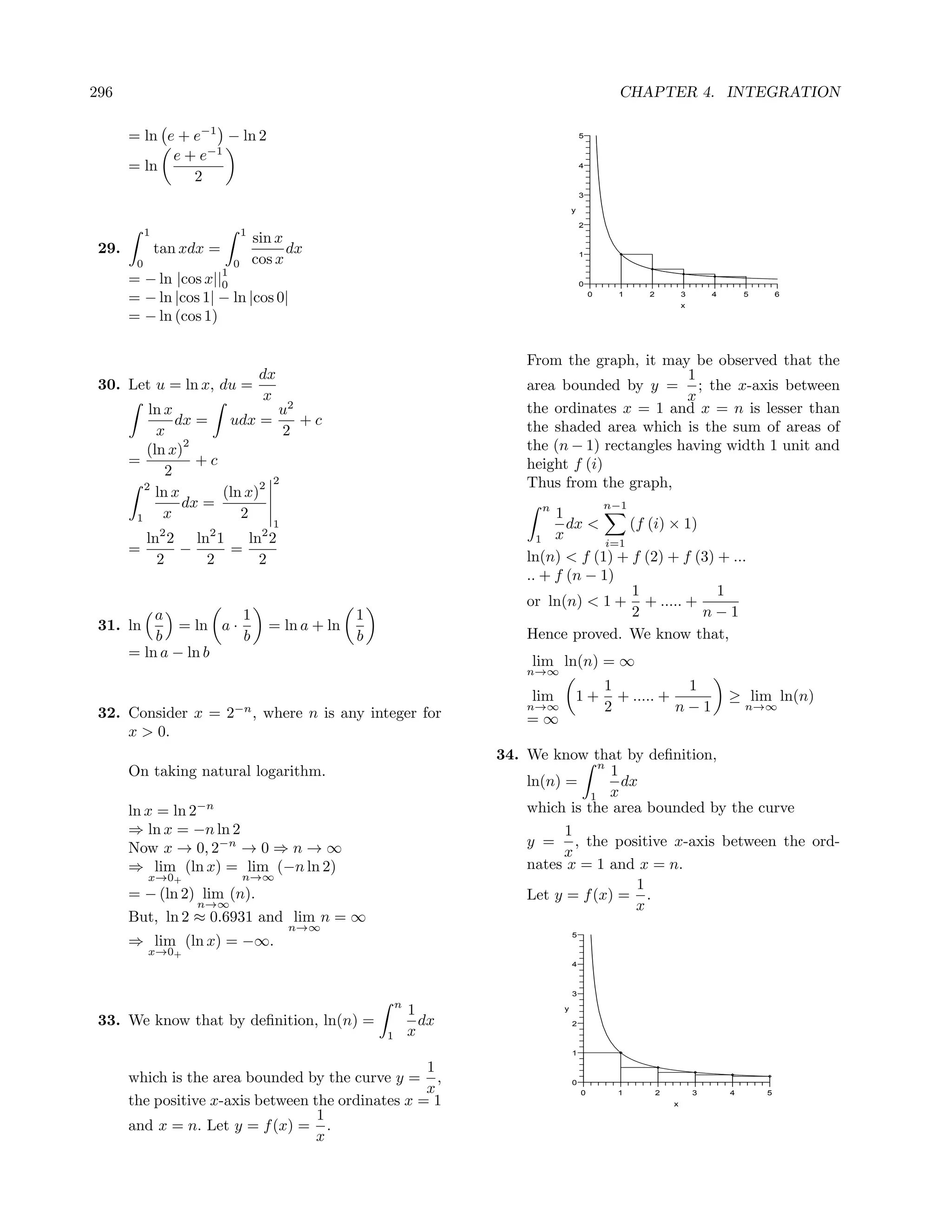
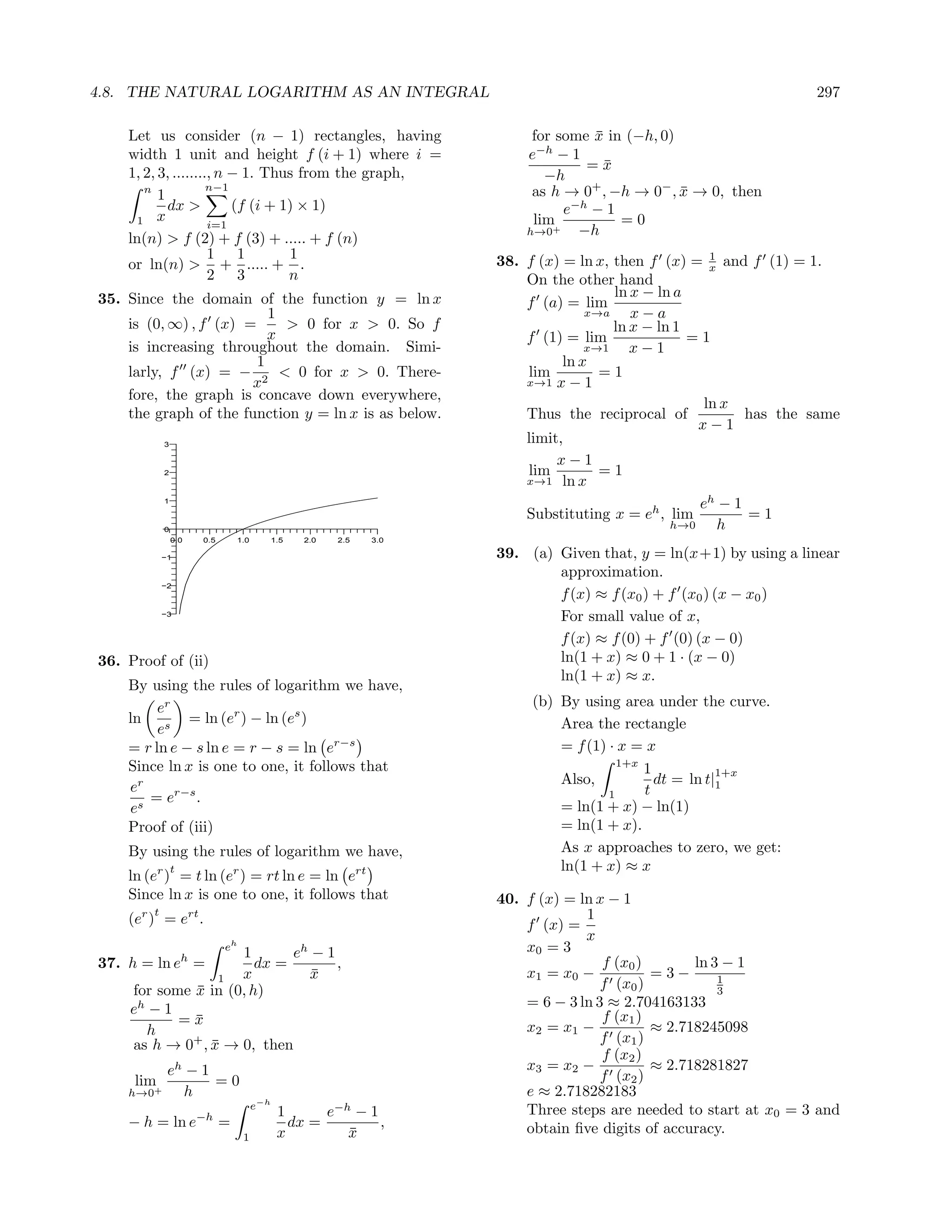

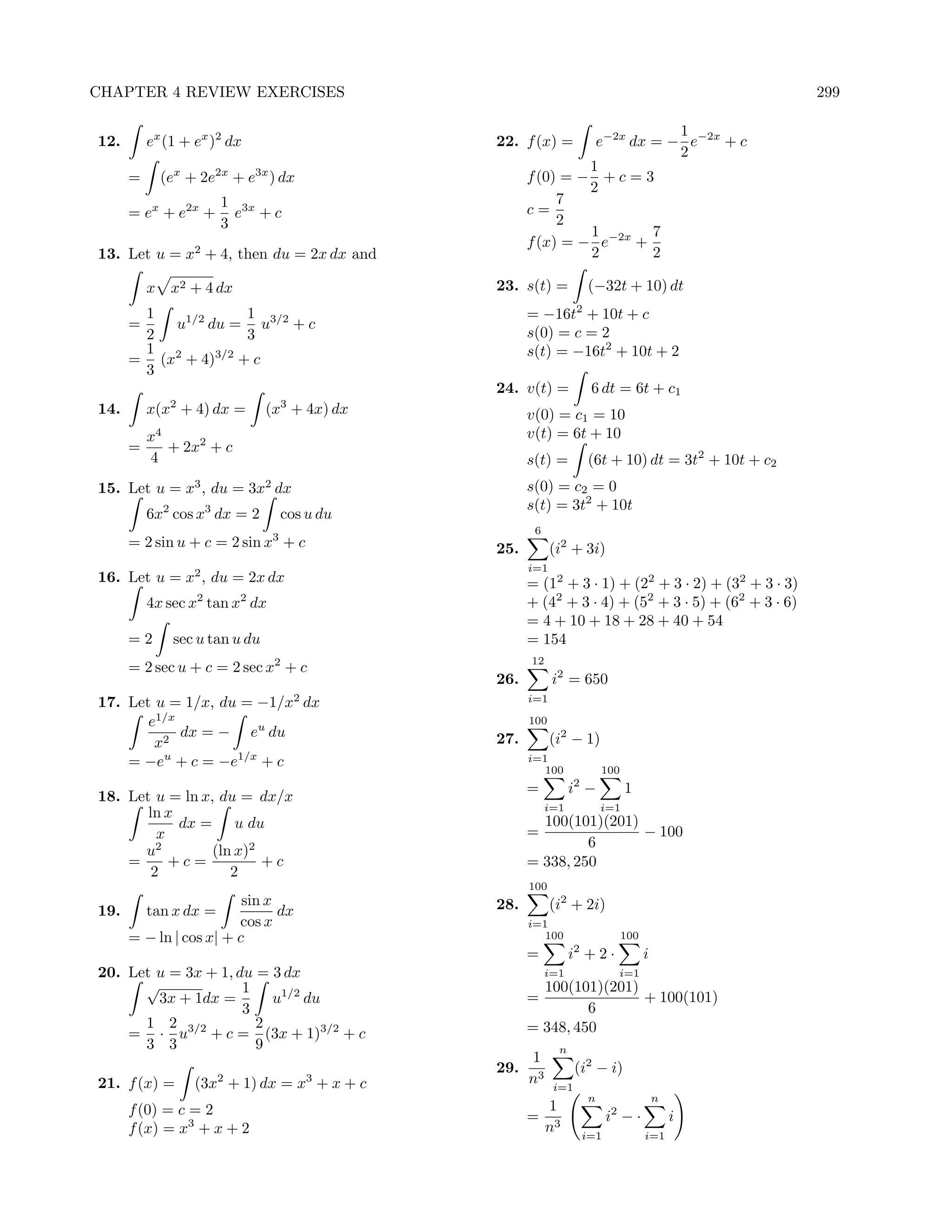
![300 CHAPTER 4. INTEGRATION
1 n(n + 1)(2n + 1) n(n + 1) + f (.6) + f (.8) + f (1) + f (1.2)
= −
n3 6 2 + f (1.4))
1
(n + 1)(2n + 1) n + 1 = (1 + 1.4 + 1.6 + 2 + 2.2 + 2.4
= − 5
6n2 2n2 + 2 + 1.6)
n
1 = 2.84
lim (i2 − i)
n→∞ n3
i=1 (b) Right-endpoints:
(n + 1)(2n + 1) n + 1 1.6
= lim − f (x) dx
n→∞ 6n2 2n2 0
2 1 1.6 − 0
= −0= ≈ (f (.2) + f (.4) + f (.6)
6 3 8
+ f (.8) + f (1) + f (1.2) + f (1.4)
30. Evaluation points: 0.25, 0.75, 1.25, 1.75
n + f (1.6))
Riemann sum = ∆x f (ci ) 1
= (1.4 + 1.6 + 2 + 2.2 + 2.4
i=1 5
4 + 2 + 1.6 + 1.4)
2
= (c2 − 2ci ) = 2.92
4 i=1 i
1 (c) Trapezoidal Rule:
= (0.252 − 2 · 0.25) + (0.752 − 2 · 0.75) 1.6
2 f (x) dx
+(1.252 − 2 · 1.25) + (1.752 − 2 · 1.75) 0
= −2.75 1.6 − 0
≈ [f (0) + 2f (.2) + 2f (.4)
2(8)
0.4
+ 2f (.6) + 2f (.8) + 2f (1)
+ 2f (1.2) + 2f (1.4) + f (1.6)]
x
0 0.5 1 1.5 2 = 2.88
0
(d) Simpson’s Rule:
1.6
-0.4
f (x) dx
0
1.6 − 0
-0.8
≈ [f (0) + 4f (.2) + 2f (.4)
3(8)
+ 4f (.6) + 2f (.8) + 4f (1)
+ 2f (1.2) + 4f (1.4) + f (1.6)]
8
2 ≈ 2.907
31. Riemann sum = c2 = 2.65625
i
8 i=1 36.
8 (a) Left-endpoints:
2
32. Riemann sum = c2 = 0.6875
i
4.2
8 i=1 f (x) dx
1
8 ≈ (0.4)[f (1.0) + f (1.4) + f (1.8)
3 + f (2.2) + f (2.6) + f (3.0)
33. Riemann sum = c2 ≈ 4.668
i
8 i=1 + f (3.4) + f (3.8)]
= (0.4)(4.0 + 3.4 + 3.6 + 3.0
8
1 + 2.6 + 2.4 + 3.0 + 3.6)
34. Riemann sum = c2 ≈ 0.6724
i = 10.24
8 i=1
(b) Right-endpoints:
35. 4.2
f (x) dx
(a) Left-endpoints: 1
1.6 ≈ (0.4)[f (1.4) + f (1.8) + f (2.2)
f (x) dx + f (2.6) + f (3.0) + f (3.4)
0
1.6 − 0 + f (3.8) + f (4.2)]
≈ (f (0) + f (.2) + f (.4) = (0.4)(3.4 + 3.6 + 3.0 + 2.6
8](https://image.slidesharecdn.com/ismetchapter4-111124021901-phpapp01/75/answers-tutor-8-61-2048.jpg)
![CHAPTER 4 REVIEW EXERCISES 301
+ 2.4 + 3.0 + 3.6 + 3.4) (n + 1)(2n + 1)
= lim
= 10.00 n→∞ 3n2
(c) Trapezoidal Rule: 2
4.2 =
3
f (x) dx
1 40. We will compute the area An of n rectangles
0.4 2
≈ [f (1.0) + 2f (1.4) + 2f (1.8) using right endpoints. In this case ∆x =
2 n
+ 2f (2.2) + 2f (2.6) + 2f (3.0) 2i
and xi =
+ 2f (3.4) + 2f (3.8) + f (4.2)] n
n n
= (0.2)[4.0 + 2(3.4) + 2(3.6) 2 2i
An = f (xi )∆x = f
+ 2(3.0) + 2(2.6) + 2(2.4) i=1
n i=1 n
+ 2(3.0) + 2(3.6) + 3.4] n 2
= 10.12 2 2i
= +1
n i=1
n
(d) Simpson’s Rule:
4.2 n n
8 2
f (x) dx = i2 + 1
1 n3 i=1
n i=1
0.4
≈ [f (1.0) + 4f (1.4) + 2f (1.8) 8 n(n + 1)(2n + 1) 2
3 = + n
+ 4f (2.2) + 2f (2.6) + 4f (3.0) n3 6 n
+ 2f (3.4) + 4f (3.8) + f (4.2)] 4(n + 1)(2n + 1)
0.4 = +2
= [4.0 + 4(3.4) + 2(3.6) 3n2
3 Now, to find the integral, we take the limit:
2
+ 4(3.0) + 2(2.6) + 4(2.4)
+ 2(3.0) + 4(3.6) + 3.4] (x2 + 1) dx = lim An
0 n→∞
≈ 10.05333 4(n + 1)(2n + 1)
= lim +2
37. See Example 7.10.
n→∞ 3n2
Simpson’s Rule is expected to be most accu- 8 14
= +2=
rate. 3 3
3
38. In this situation, the Midpoint Rule will be less 41. Area = (3x − x2 ) dx
than the actual integral. The Trapezoid Rule 0
will be an overestimate. 3x2 x3 3 9
= − =
2 3 0 2
39. We will compute the area An of n rectangles
1
using right endpoints. In this case ∆x = n and 42. Area
1
xi = ni = (x3 − 3x2 + 2x) dx
n n 0
1 i 2
An = f (xi )∆x = f − (x3 − 3x2 + 2x) dx
i=1
n i=1 n
1
n 2 1 1 1
1 i = + =
= 2· 4 4 2
n n
i=1 43. The velocity is always positive, so distance
n traveled is equal to change in position.
2
= i2 2
n3 i=1 Dist = (40 − 10t) dt
1
2 n(n + 1)(2n + 1) 2
= = (40t − 5t2 ) = 25
n3 6 1
(n + 1)(2n + 1) 44. The velocity is always positive, so distance
= traveled is equal to change in position.
3n2 2 2
Now, to find the integral, we take the limit: Dist = 20e−t/2 dt = (−40e−t/2 )
1 0
0
x2 dx = lim An = 40(−e−1 + 40) ≈ 25.2848
0 n→∞](https://image.slidesharecdn.com/ismetchapter4-111124021901-phpapp01/75/answers-tutor-8-62-2048.jpg)
![302 CHAPTER 4. INTEGRATION
2 π
1 e2 − 1
45. fave = ex dx = ≈ 3.19 58. cos(x/2) dx
2 0 2 −π
π
1 4
8 = (2 sin(x/2)) =4
−π
46. fave = (4x − x2 ) dx =
4 0 3
59. f (x) = sin x2 − 2
2 3 2
x 4
47. (x2 − 2) dx = − 2x =−
0 3 0 3 60. f (x) = (x2 )2 + 1 · 2x
1
x4 1 61.
48. (x3 − 2x) dx = − x2 =0
−1 4 −1
a) Midpoint Rule:
π/2 π/2 1
1
49. sin 2x dx = − cos 2x =1 x2 + 4 dx
0 2 0 0
1−0 1 3
π/4 π/4 ≈ f +f
50. 2
sec x dx = tan x =1 4 8 8
0 0
5 7
10 +f +f
51. (1 − e −t/4
) dt 8 8
0
10
≈ 2.079
= t + 4e−t/4 = 6 + 4e−5/2
0 b) Trapezoidal Rule:
1 1
52. te −t2
dt x2 + 4 dx
0 0
1 1 1 1−0 1
= − e−t
2
= − (e−1 − 1) ≈ f (0) + 2f
2 0 2 2(4) 4
2 2
1 3
x 1 +2f + 2f
53. 2+1
dx = ln |x2 + 1| 2 4
0 x 2 0
ln 5 +f (1)]
= ≈ 2.083
2
2
ln x ln2 x 2 ln2 2 c) Simpson’s Rule:
54. dx = = 1
1 x 2 1 2 x2 + 4 dx
2 0
55. x x2 + 4 dx 1−0 1
≈ f (0) + 4f
0 3(4) 4
1 2 2
= · · (x2 + 4)3/2 1 3
2 3 0 +2f + 4f + f (1)
√ 2 4
16 2 − 8 ≈ 2.080
=
3
2 62.
56. x(x2 + 1) dx
0 a) Midpoint Rule:
1 2 2 2
= (x + 1)2 =6 e−x
2
/4
dx
4 0
0
1 1 2
x ≈ [f (0.25) + f (0.75)
57. (ex − 2)2 dx = (e2x−4e +4
) dx 4
0 0
+ f (1.25) + f (1.75)]
1 2x 2
= e − 4ex + 4x ≈ 1.497494
2 0
2 b) Trapezoidal Rule:
e 1 2
= − 4e + 4 − −4 2
2 2 e−x /4
dx
0
e2 15 2
= − 4e + ≈ [f (0) + 2f (.5) + 2f (1)
2 2 8](https://image.slidesharecdn.com/ismetchapter4-111124021901-phpapp01/75/answers-tutor-8-63-2048.jpg)
![CHAPTER 4 REVIEW EXERCISES 303
t t
+ 2f (1.5) + f (2)] e 2 −e− 2
2 t t
≈ 1.485968 2u e 2 +e− 2
similarly, = 2
1 + u2 t
e 2 −e− 2
t
c) Simpson’s Rule: 1+ t t
e 2 +e− 2
2 t t t t
e−x
2
/4
dx 2 e 2 − e− 2 e2 + e −2
0 = 2 2
2 t
e 2 + e− 2
t t
+ e 2 − e− 2
t
≈ [f (0) + 4f (.5) + 2f (1)
12 2 (et − e−t )
+ 4f (1.5) + f (2)] = = sinh t
4
≈ 1.493711
1
(a) dt
63. sinh t + cosh t
n Midpoint Trapezoid Simpson’s 1
= (1+u2
du
20 2.08041 2.08055 2.08046 + (1−u2 )
2u
(1−u2 ) )
40 2.08045 2.08048 2.08046 (Put:u = tanh(t/2))
1 − u2
64. = 2 du
n Midpoint Trapezoid Simpson’s (1 + u)
1−u
20 1.493802 1.493342 1.493648 = du
1+u
40 1.493687 1.493572 1.493648
2
= − 1 du
t
1+u
t sinh 2 = 2 ln (1 + u) − u
65. Consider u = tanh 2 = t
cosh 2 = 2 ln (1 + tanh(t/2)) − tanh(t/2)
t t
e 2 −e− 2 t t
sinh t + cosh t
2 e 2 − e− 2 (b) dt
= t t = 1 + cosh t
e 2 +e− 2 t
e 2 + e− 2
t
2 2u (1+u2 )
2 (1−u2 ) + (1−u2 )
t
e 2 −e− 2
t = (1+u2
du
1 − u2 1− t t
e 2 +e− 2
1 + (1−u2 ))
therefore = 2 2
1 + u2 t
e 2 −e− 2
t (1 + u)
1+ t t = du
e 2 +e− 2 2
t t
2 t t
2 3
e 2 + e− 2 − e2 − e −2 1 (1 + u)
=
= 2 2 2 3
t t t t
e 2 + e− 2 + e 2 − e− 2 3
(1 + tanh(t/2))
t
2 (e + e ) −t =
= = cosh t , 6
4](https://image.slidesharecdn.com/ismetchapter4-111124021901-phpapp01/75/answers-tutor-8-64-2048.jpg)